Navigation
- Upgrade
- New Install Preparation
- Delivery Controller 7.13 Install
- Studio – Slow Launch
- Local Host Cache
- Database Maintenance – Change Database connection strings, read-committed snapshot, Director grooming, Logging Database operations, etc.
- Export/Import Configuration
- Studio Administrators
- Customer Experience Improvement Program (CEIP)
- vCenter Connection – Hosting Resources
- Citrix Licensing Server
- Remote Desktop Licensing Server
- Smart Check 💡
- Health Check
💡 = Recently Updated
Upgrade
If you are performing a new install of XenApp/XenDesktop Controller, then skip to the next section.
You can upgrade directly from any Delivery Controller version 5.6 or newer.
Before upgrading, if you have a standalone Citrix Licensing Server, upgrade it to 11.14.0.1 build 19005.

During the upgrade of Delivery Controller, be aware that a database upgrade is required. Either get a DBA to grant you temporary sysadmin permission, or use Citrix Studio to generate SQL scripts that a DBA must then run in SQL Studio.
- If StoreFront is installed on the Controller, and if the Citrix SCOM Agent for StoreFront is installed, stop the Citrix MPSF Agent service. See CTX220935 Cannot Perform a StoreFront Upgrade if Citrix SCOM Management Pack Agent Service is Running.
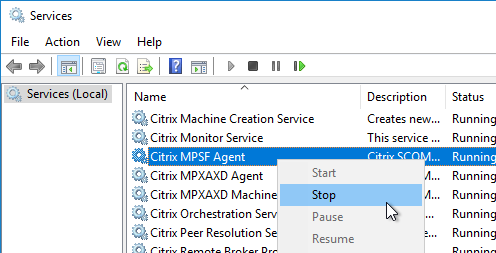
- Close PowerShell/Consoles. Make sure all Citrix Consoles and PowerShell consoles are closed. StoreFront won’t upgrade if any are running. If StoreFront fails, then the StoreFront configuration is wiped out.
- Snapshot. If StoreFront is on the Controller, take a snapshot before attempting the upgrade.
- Another option is to export the StoreFront configuration so you can restore it later if something goes wrong.
- Run AutoSelect.exe from the XenApp/XenDesktop 7.13 ISO.
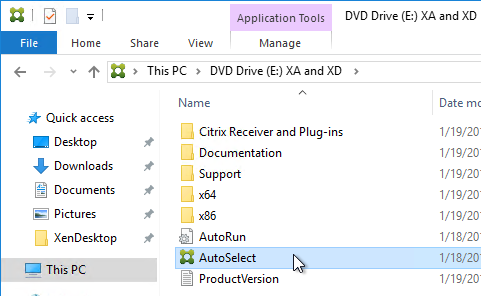
- On the top left, click Studio and Server Components.
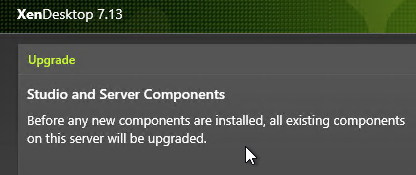
- In the Licensing Agreement page, select I have read, understand, and accept the terms, and click Next.
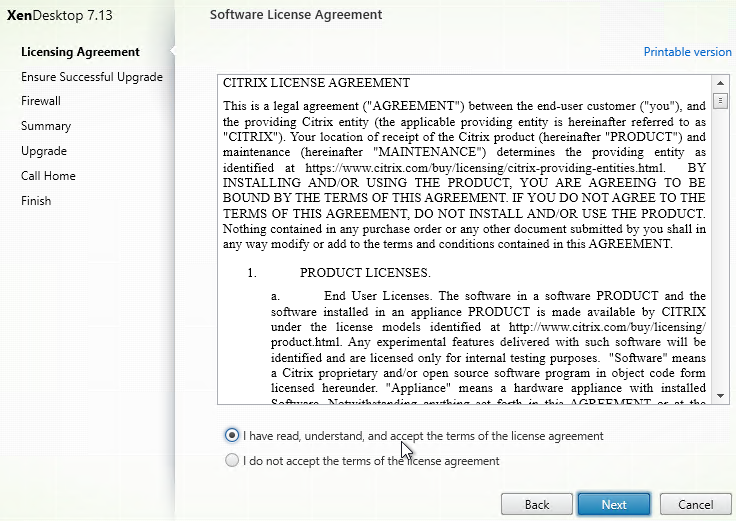
- In the Ensure Successful Upgrade page, read the steps, check the box next to I’m ready to continue, and click Next.
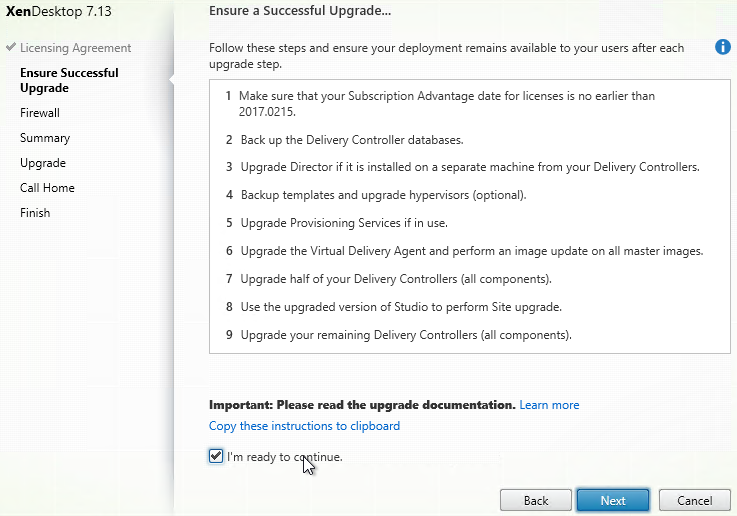
- In the Firewall page, click Next.
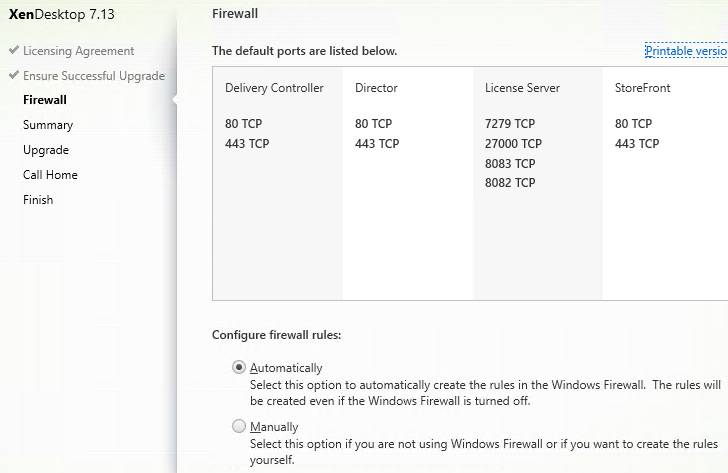
- In the Summary page, click Upgrade.
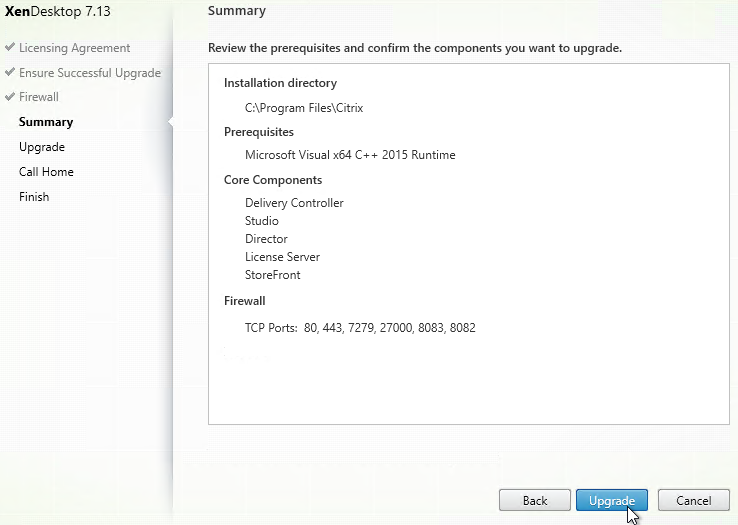
- If you see a Running Processes window, close the listed programs, and click Continue.
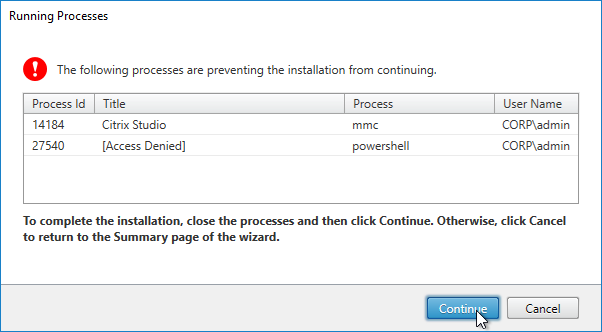
- Click Close if prompted to restart.

- If you see a window asking you to Locate XenDesktop installation media, click Cancel.
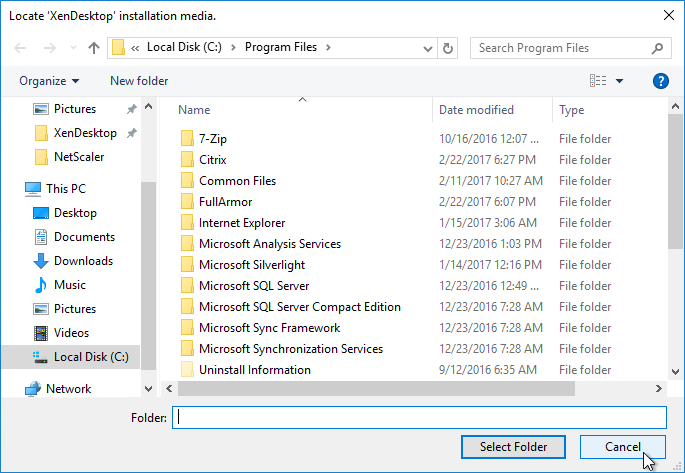
- Mount the XenApp_and_XenDesktop_7_13.iso.
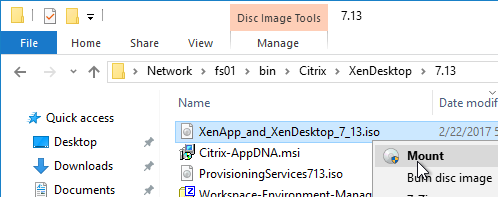
- Run AutoSelect.exe.
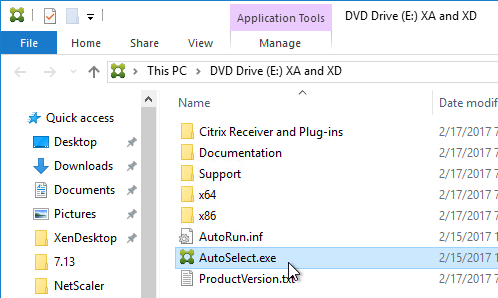
- Click Delivery Controller and installation will resume.
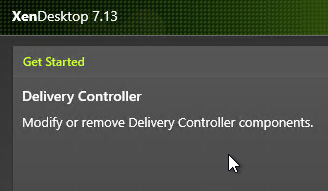
- In the Call Home page, make a selection. If participating, click Connect, login, and then click Next.
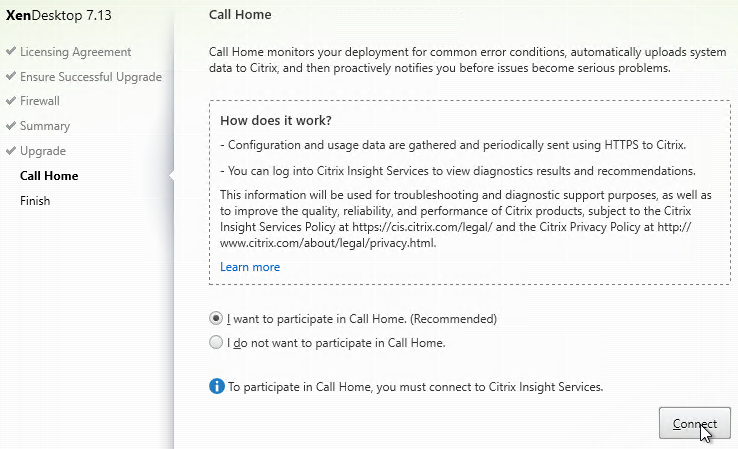
- In the Finish page, check the box next to Launch Studio, and click Finish.
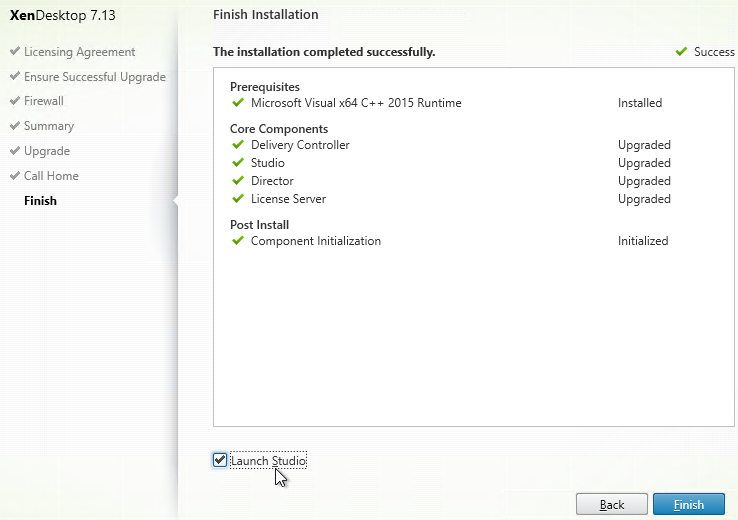
- After Citrix Studio launches, if you have sysadmin permissions on SQL, then click Start the automatic Site upgrade. If you don’t have full permission, then get a DBA to help you, click Manually upgrade this site, and follow the instructions.
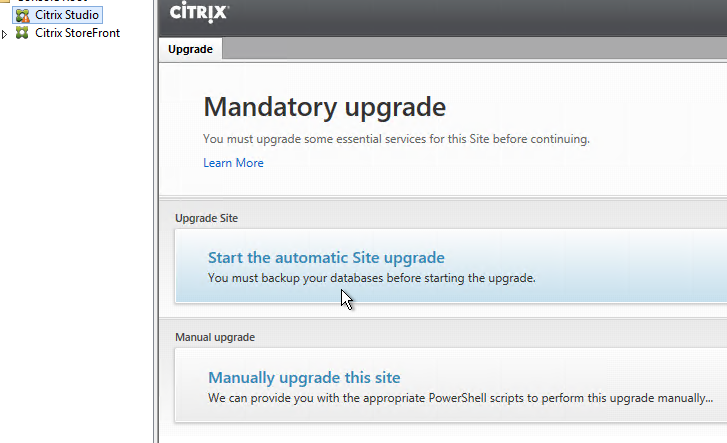
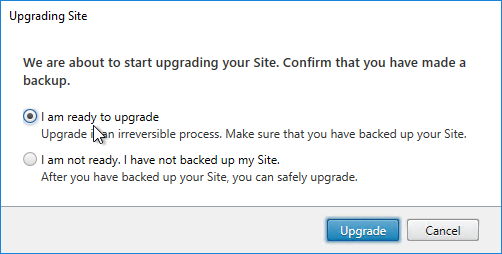
- If you choose to Manually upgrade this site, and if you are upgrading from 7.11, then note that there’s no upgrade for the Logging Database schema, so there won’t be any SQL script for the Logging database.
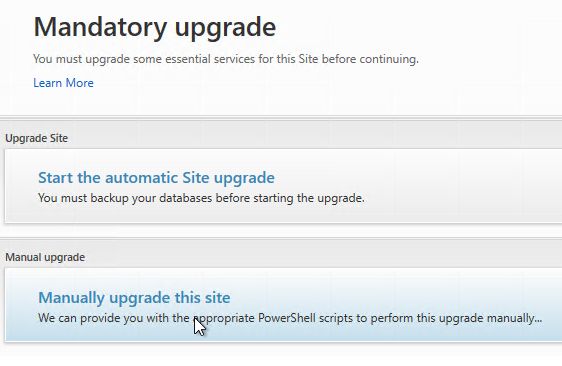
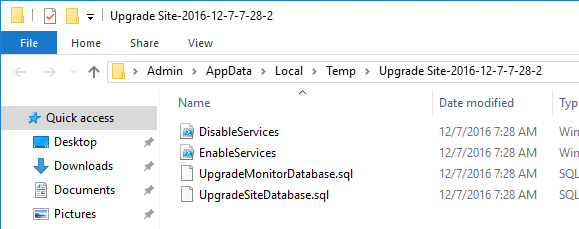
- After all Controllers and VDAs are upgraded, right-click the Catalogs, and click Upgrade Catalog. Note: 7.9 is the newest minimum functional level. You won’t see an option for 7.13. If your Catalogs are already set to VDA version 7.9, then no upgrade is needed.
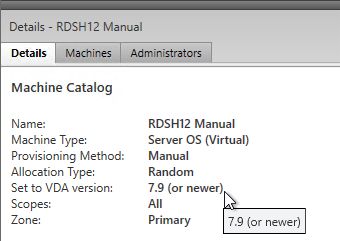
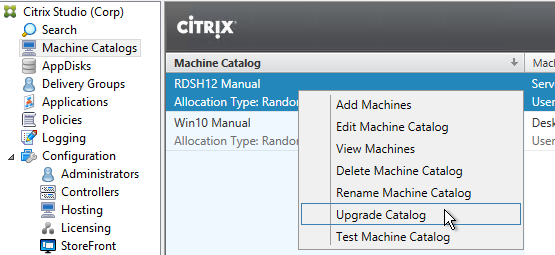
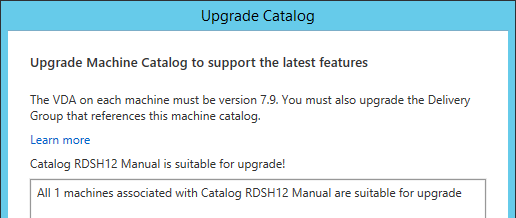
- Then do the same for the Delivery Groups. Note: 7.9 is the newest minimum functional level. You won’t see an option for 7.13. If your Delivery Groups are already set to VDA version 7.9, then no upgrade is needed.
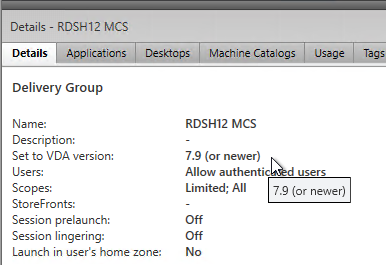
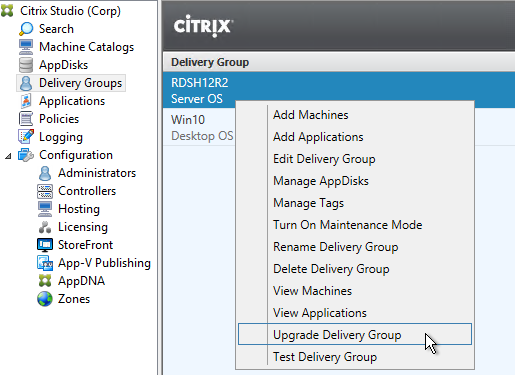
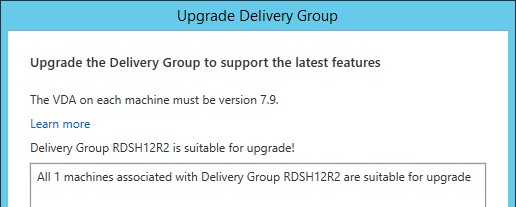
Other XenApp/XenDesktop components can also be in-place upgraded:
- StoreFront
- Director
- VDAs
- Citrix Policy Management Plug-in
- Profile Management Group Policy Templates
- Receiver Group Policy Templates
- Workspace Environment Manager
- AppDNA
- Provisioning Services
- SCOM Management Packs
- Session Recording
- Federated Authentication Service
New Install Preparation
Automation – If you want to automate the install of Delivery Controllers, see Dennis Span Citrix Delivery Controller unattended installation with PowerShell and SCCM.
Citrix Licensing – If you are going to use an existing Citrix Licensing Server, upgrade it to 11.14.0.1 build 19005.

SQL Databases
- Citrix CTX209080 Database Sizing Tool for XenDesktop 7
- Citrix article CTX114501 – Supported Databases for XenApp and XenDesktop Components
- There are typically three databases: one for the Site (aka farm), one for Logging (audit log) and one for Monitoring (Director).
- The name of the monitoring database must not have any spaces in it. See CTX200325 Database Naming Limitation when Citrix Director Accesses Monitoring Data Using OData APIs
- If you want Citrix Studio to create the SQL databases automatically, then the person running Studio must be a sysadmin on the SQL instances. No lesser role will work. sysadmin permissions can be granted temporarily and revoked after installation.
- As an alternative, you can use Citrix Studio to create SQL scripts and then run those scripts on the SQL server. In that case, the person running the scripts only needs the dbcreator and securityadmin roles.
- It is possible to create the databases in advance. However, you must use the non-default Latin1_General_100_CI_AS_KS collation. Then use Citrix Studio to configure the database tables.
- If SQL 2016 or newer, create a Basic Availability Group.
- Only SQL Standard Edition is required. There’s no need for SQL Enterprise Edition.
- Two SQL Standard Edition servers plus a file share witness. No more SQL Express.
- The Basic Availability Group has an AAG listener. Point XenDesktop to the listener.
- To setup SQL Basic Availability Group, see Carl Webster Implementing Microsoft SQL Server 2016 Standard Basic Availability Groups for Use in Citrix XenApp and XenDesktop 7.9.
- If SQL 2014 or older, Citrix recommends SQL Mirroring because it has the fastest failover.
- SQL Mirroring requires two SQL Standard Edition servers and one SQL Express for the witness server.
- You can setup SQL Mirroring either before installing XenDesktop or after installing XenDesktop. If after, then see Citrix CTX140319 to manually change XenDesktop’s database connection strings How to Migrate XenDesktop Database to New SQL Server.
- To setup SQL Mirroring, see Rob Cartwright: Configure SQL Mirroring For Use With XenDesktop, XenApp, and PVS Databases.
- If you try to stretch the mirror across datacenters, the SQL witness must be placed in a third datacenter that has connectivity to the other two datacenters. However, stretching a single XenApp/XenDesktop site/farm and corresponding SQL mirror across datacenters is not recommended.
- AlwaysOn Availability Groups and SQL Clustering are also supported. However, these features require the much more expensive SQL Enterprise Edition.
Windows Features
- Installing Group Policy Management on the Delivery Controller lets you edit GPOs and have access to the Citrix Policies node in the GPO Editor. Or you can install Citrix Studio on a different machine that has GPMC installed.
vSphere
- Create a role in vSphere Client. Assign a service account to the role at the Datacenter or higher level.
Delivery Controller Install
- A typical size for the Controller VMs is 2-4 vCPU and 8+ GB of RAM. If all components (Delivery Controller, StoreFront, Licensing, Director, SQL Express) are installed on one server, then you might want to bump up memory to 10 GB or 12 GB.
- From Local Host Cache sizing and scaling at Citrix Docs:
- For LHC LocalDB, assign the Controller VMs a single socket with multiple cores.
- Add two cores for LHC.
- Add at least three more Gigs of RAM and watch the memory consumption.
- Since there’s no control over LHC election, ensure all Controllers have the same specs.
- Make sure the User Right Log on as a service includes NT SERVICE\ALL SERVICES or add NT SERVICE\CitrixTelemetryService to the User Right.
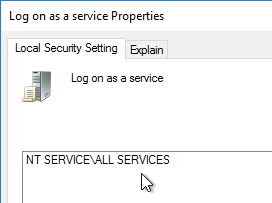
- On two Delivery Controllers, install the Delivery Controller software from the XenApp/XenDesktop 7.13 ISO. Go to the extracted ISO and run AutoSelect.exe.
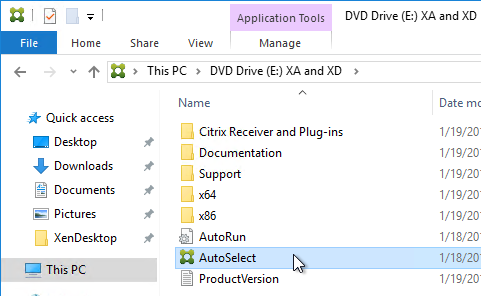
- Click Start next to either XenApp or XenDesktop. The only difference is the product name displayed in the installation wizard.
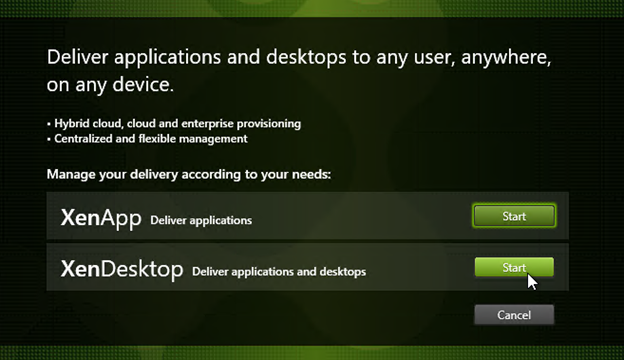
- On the left, click Delivery Controller.
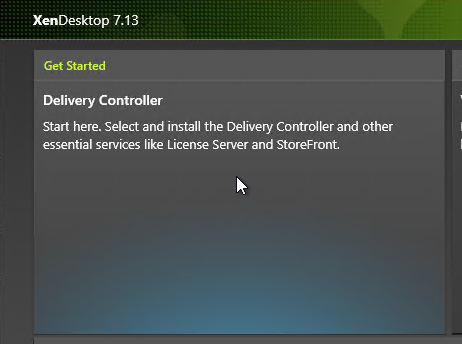
- In the Licensing Agreement page, select I have read, understand, and accept, and click Next.
- In the Core Components page, you can install all components on one server, or on separate servers. Splitting them out is only necessary in large environments, or if you have multiple farms and want to share the Licensing, StoreFront, and Director components across those farms.
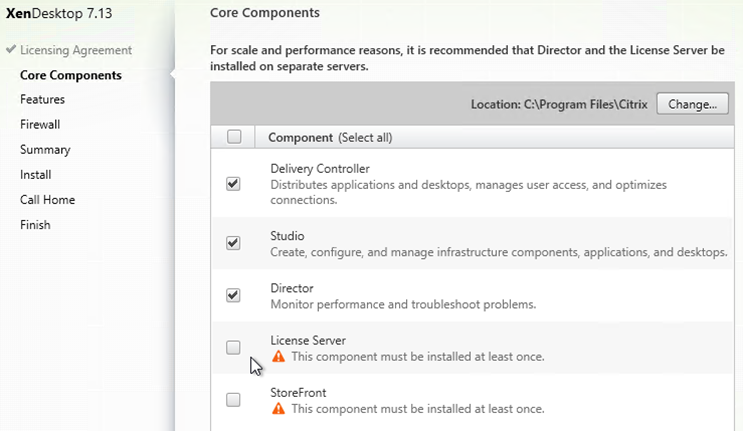
- In the Features page, uncheck the box next to Install Microsoft SQL Server 2014 SP2 Express, and click Next.

- In the Firewall page, click Next.
- In the Summary page, click Install.
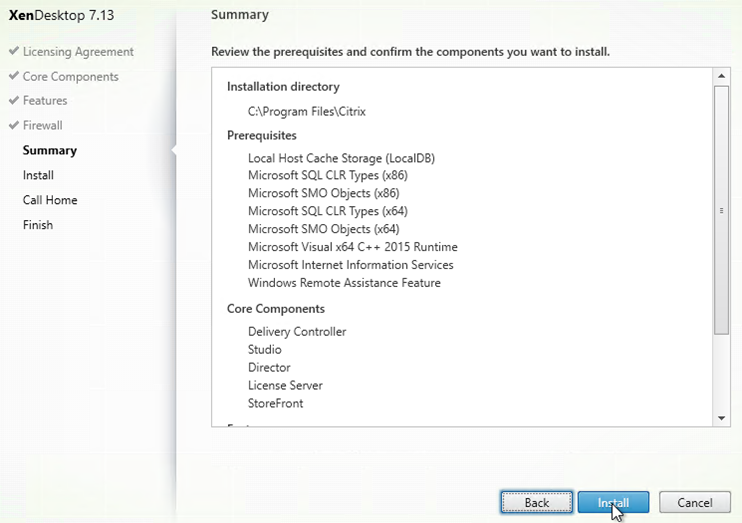
- In the Call Home page, make a selection, click Connect, enter your MyCitrix credentials, and then click Next.
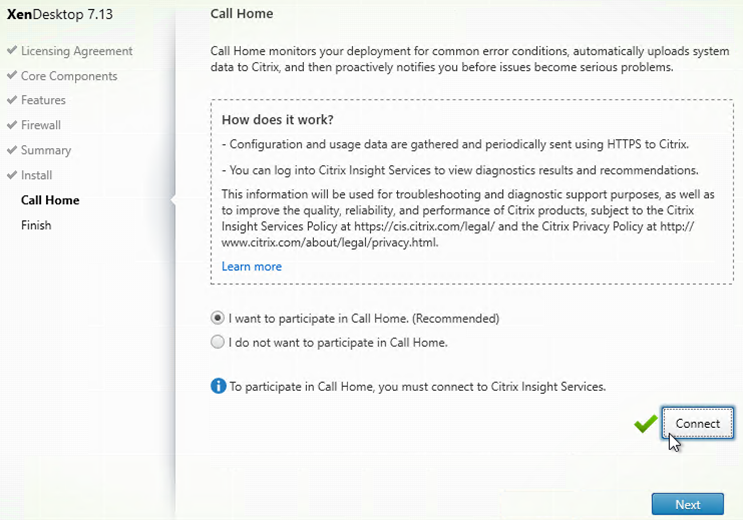
- In the Finish page, click Finish. Studio will automatically launch.
- Ensure the two Controller VMs do not run on the same hypervisor host. Create an anti-affinity rule.
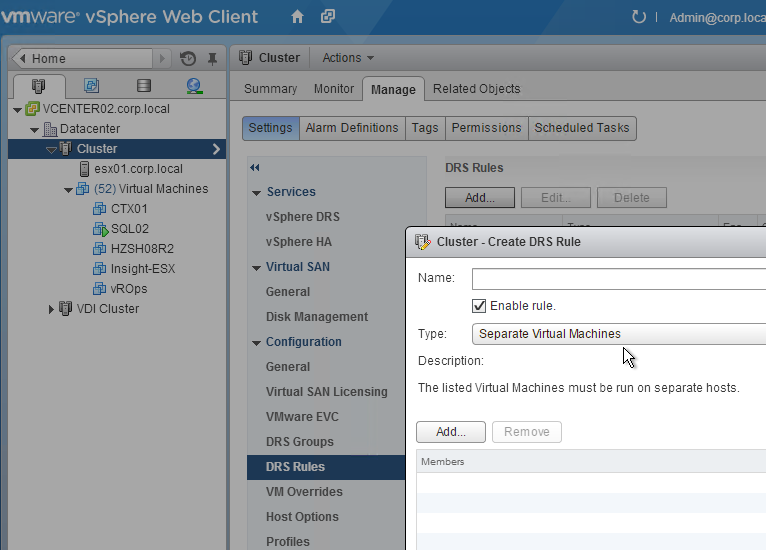
Create Site
There are several methods of creating the databases for XenApp/XenDesktop:
- If you have sysadmin permissions to SQL, let Citrix Studio create the databases automatically.
- If you don’t have sysadmin permissions to SQL, then use Citrix Studio to generate SQL scripts, and send them to a DBA.
Use Studio to Create Database Scripts
- Launch Citrix Studio. After it loads, click Deliver applications and desktops to your users.
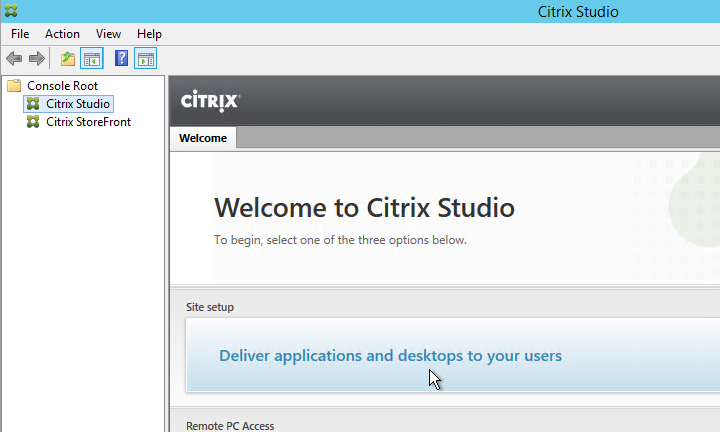
- In the Introduction page, select An empty, unconfigured site. This reduces the number of pages in this Setup wizard. The other pages will be configured later.
- Enter a Site Name (aka farm name), and click Next. Only administrators see the farm name.
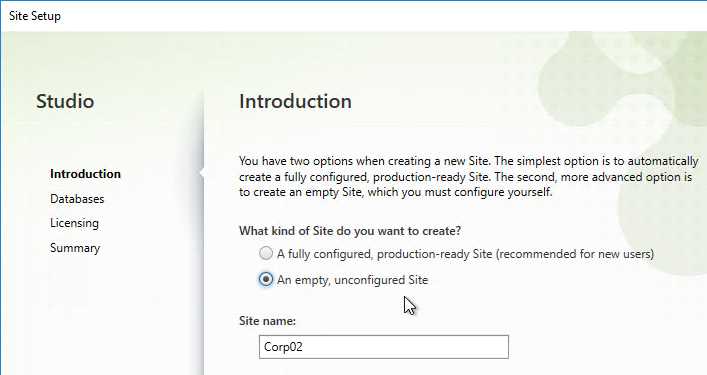
- In the Databases page, if you are building two Controllers, click Select near the bottom of the same page.
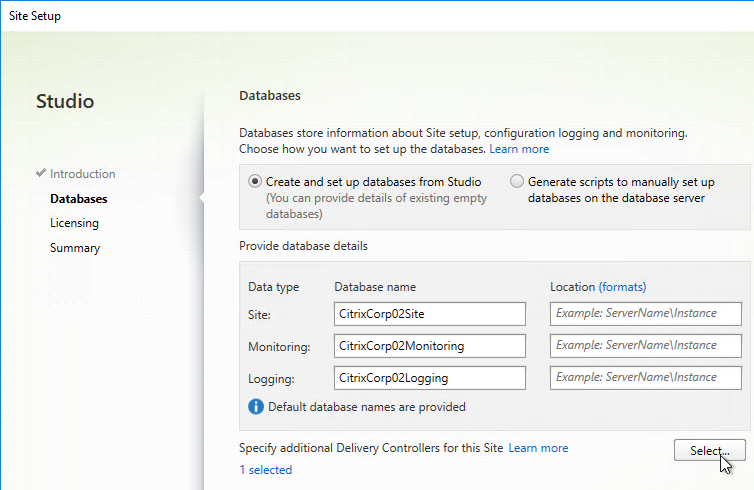
- Click Add.
- Enter the FQDN of the second Controller and click OK. Note: the Delivery Controller software must already be installed on that machine.
- Then click Save.
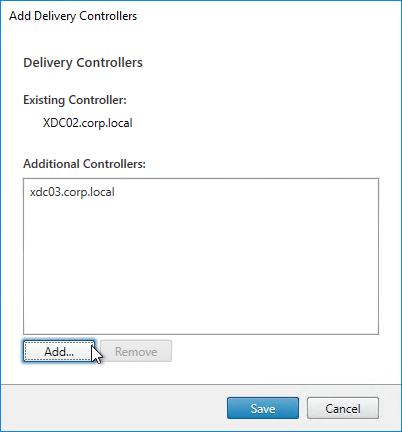
- If you don’t have sysadmin permissions, change the selection to Generate scripts to manually set up databases on the database server. Change the database names if desired, and click Next.
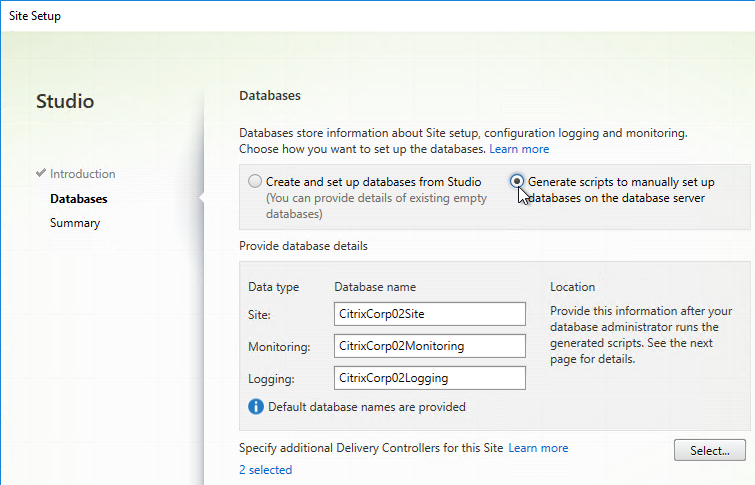
- In the Summary page, click Generate scripts.
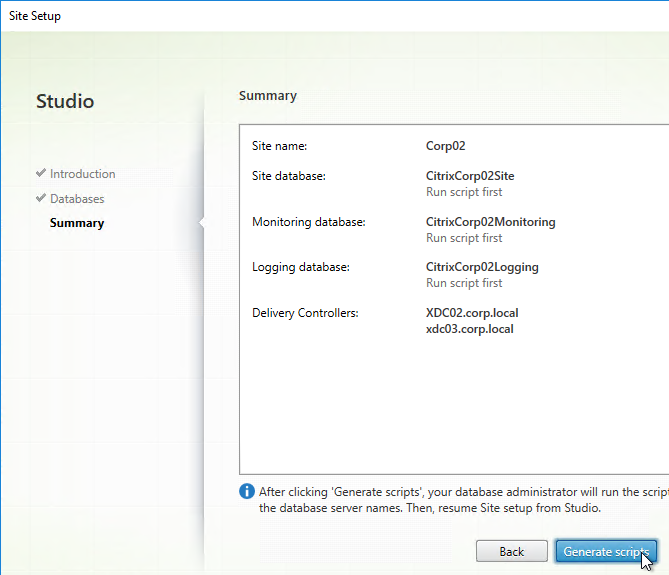
- A folder will open with six scripts. Edit each of the scripts.
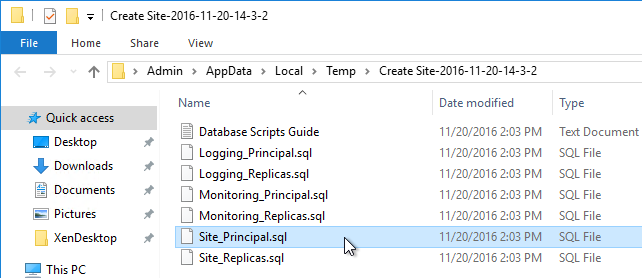
- Near the top of each script are two lines to create the database. Uncomment both lines (including the go line). Then save and close the file.
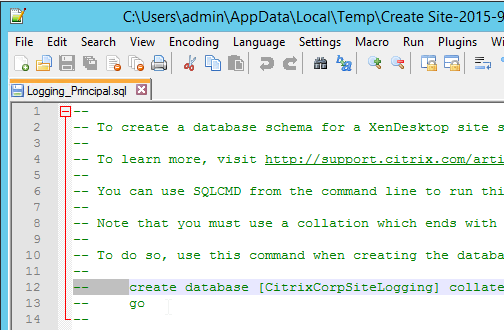
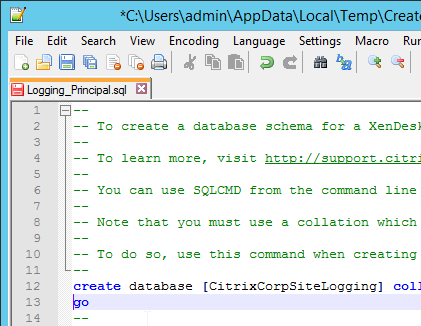
- Once all of the scripts are edited, you can send them to your DBA.
- On the Principal SQL Server, open the file Site_Principal.sql.
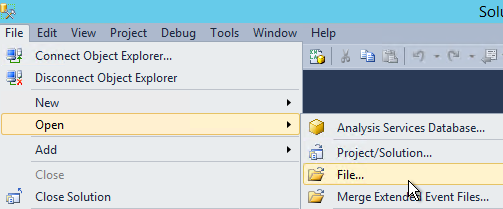
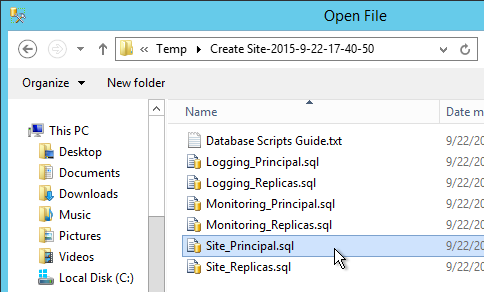
- Open the Query menu, and click SQLCMD Mode.
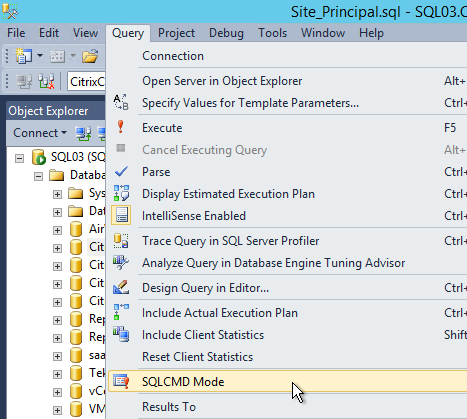
- Then execute the script.
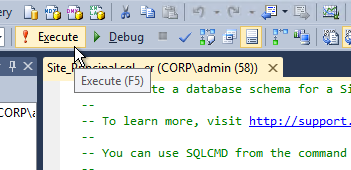
- If SQLCMD mode was enabled properly, then the output should look something like this:
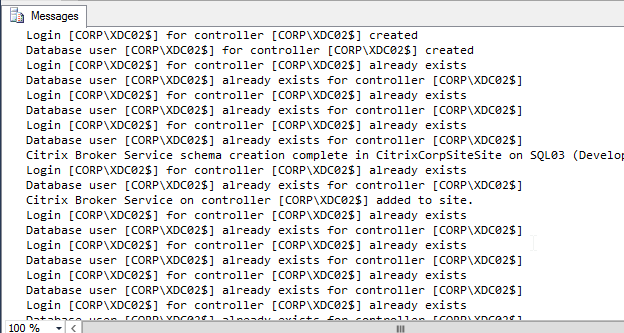
- If you have a mirrored database, run the second script on the mirror SQL instance. Make sure SQLCMD mode is enabled.

- Repeat for the Logging_Principal.sql script.
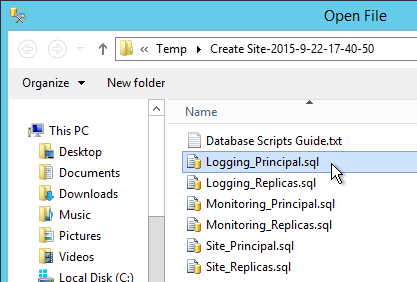
- You’ll have to enable SQLCMD Mode for each script you open.
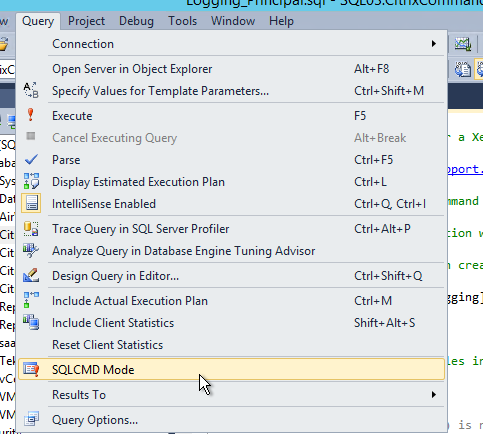
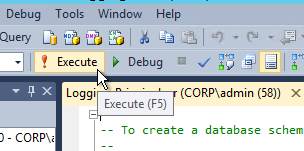

- Repeat for the Monitoring_Principal.sql script.
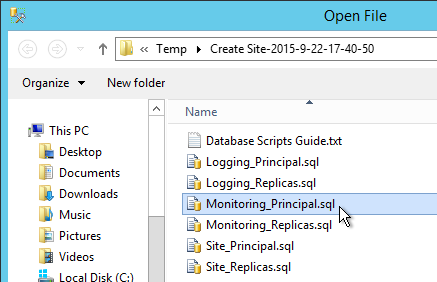
- Once again enable SQLCMD Mode.
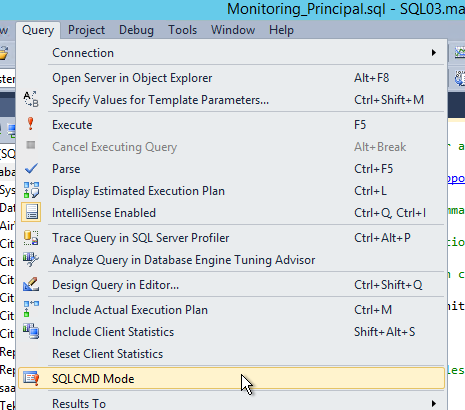
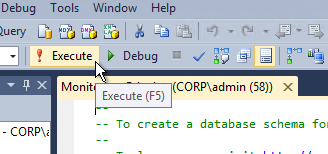
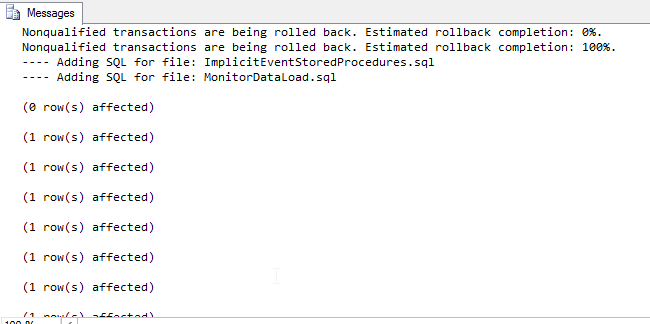
- The person running Citrix Studio must be added to the SQL Server as a SQL Login, and granted the public server role.
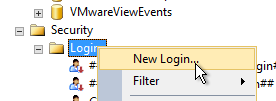
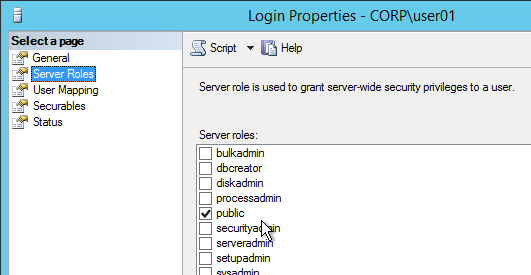
- Back in Citrix Studio, click the Continue database configuration and Site setup button.
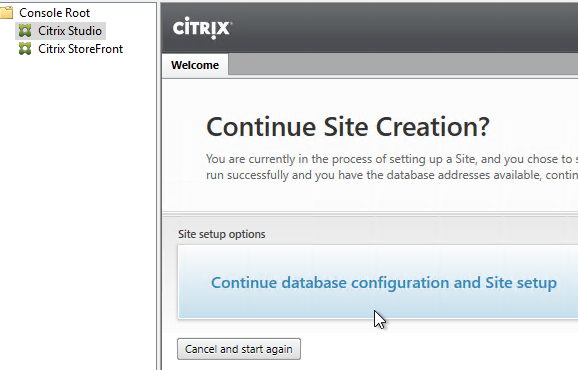
- In the Databases page, enter the SQL server name, and instance name, and click Next.
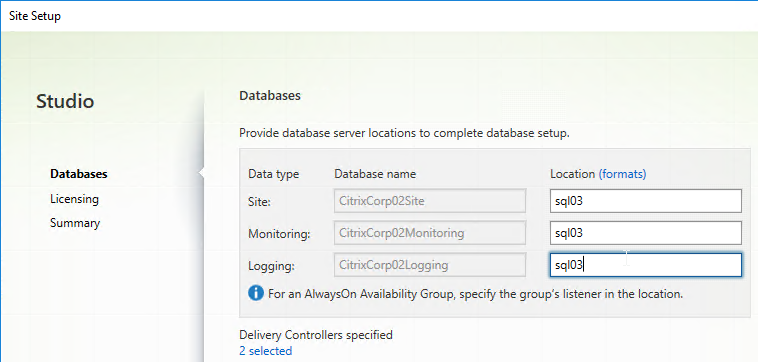
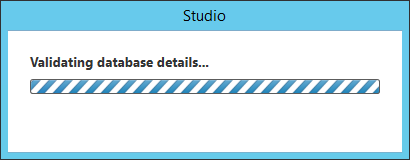
- On the Licensing page, enter the name of the Citrix License Server, and click Connect. If you installed Licensing with your Delivery Controller, then simply enter localhost.
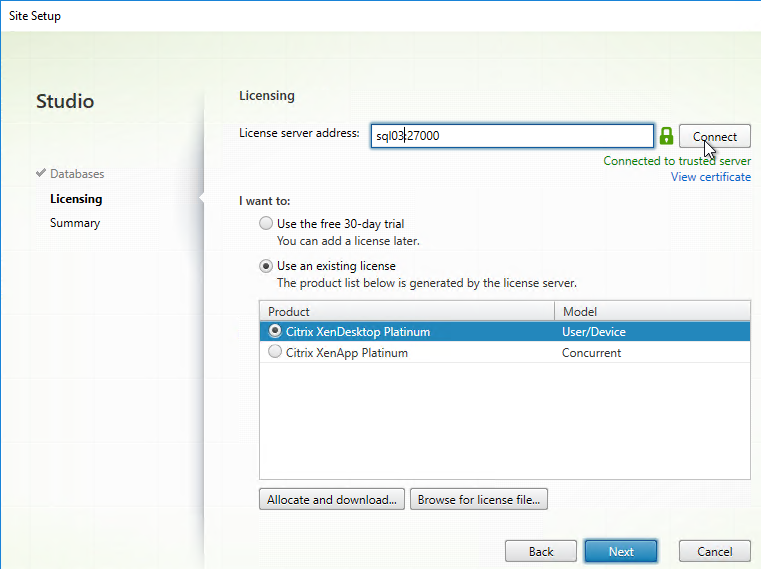
- XenApp/XenDesktop 7.13 requires the newest Licensing Server. If your server isn’t compatible, leave it set to localhost and fix it later.
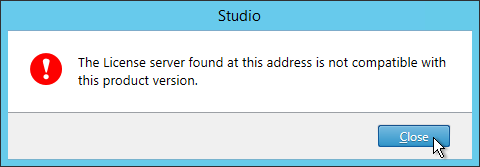
- If the Certificate Authentication appears, select Connect me, and click Confirm.
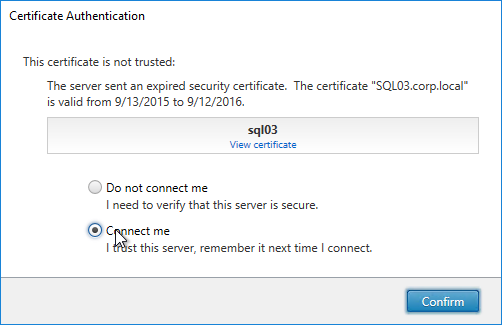
- Then select your license, and click Next.
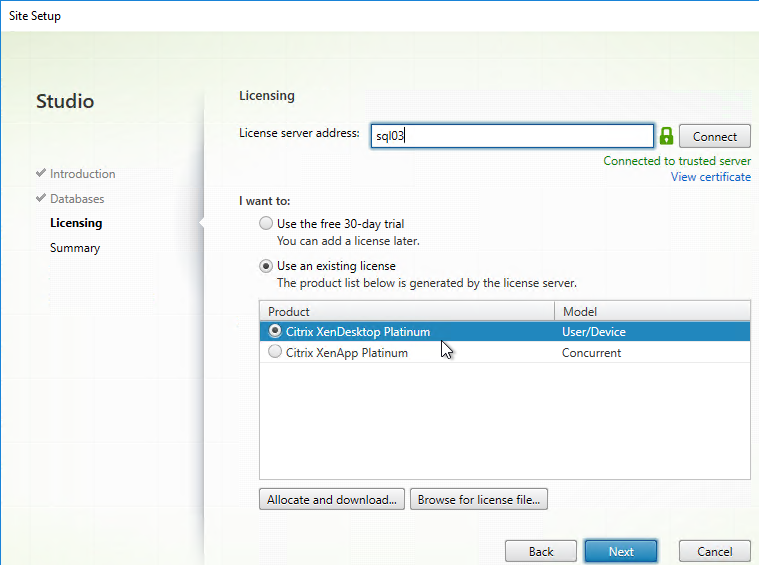
- In the Summary page, if your databases are mirrored, each database will show high availability servers, and the name of the Mirror server. Click Finish.
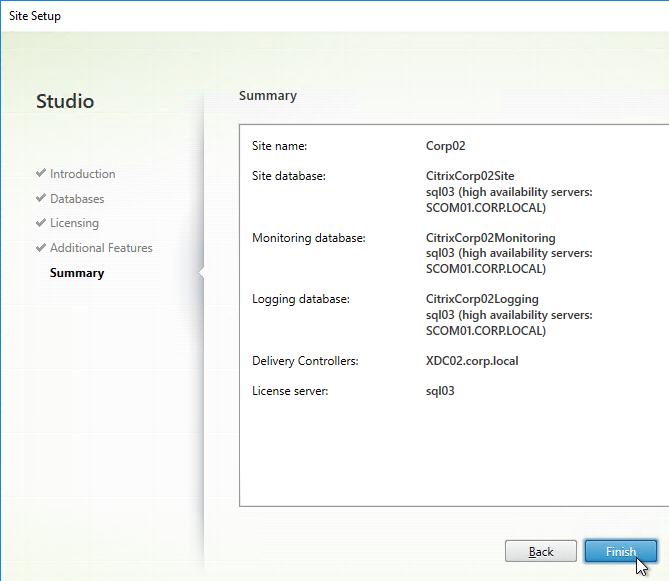
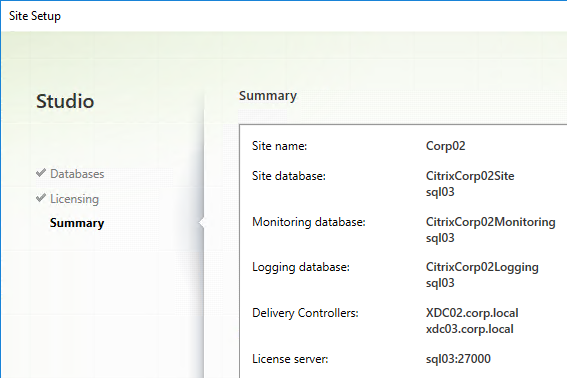
- It will take some time for the site to be created.
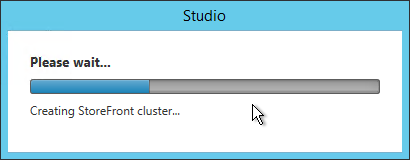
Verify Database Mirroring
If your database is mirrored, when you run asnp citrix.* and then run get-brokerdbconnection, you’ll see the Failover Partner in the database connection string.

Second Controller
When building the first Delivery Controller, the scripts might have already included the second Delivery Controller. Thus no special SQL permissions are needed. If the second Delivery Controller has not already been added to the SQL databases, then there are several methods of adding a second Controller to the databases for XenApp/XenDesktop:
- If you have sysadmin permissions to SQL, let Citrix Studio modify the databases automatically.
- If you don’t have sysadmin permissions to SQL then use Citrix Studio to generate SQL scripts and send them to a DBA.
To use Citrix Studio to create the SQL Scripts:
- On the first Delivery Controller, if StoreFront is installed, delete the default StoreFront store (/Citrix/Store) and recreate it with your desired Store name (e.g. /Citrix/CompanyStore).
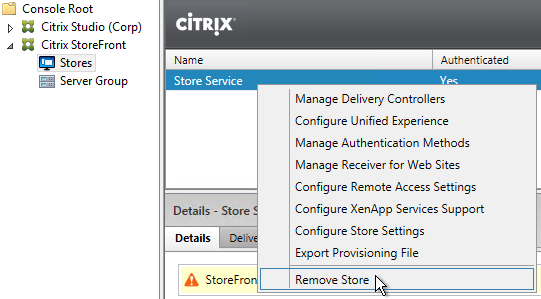
- On the 2nd Delivery Controller, install XenDesktop as detailed earlier.
- After running Studio, click Connect this Delivery Controller to an existing Site.
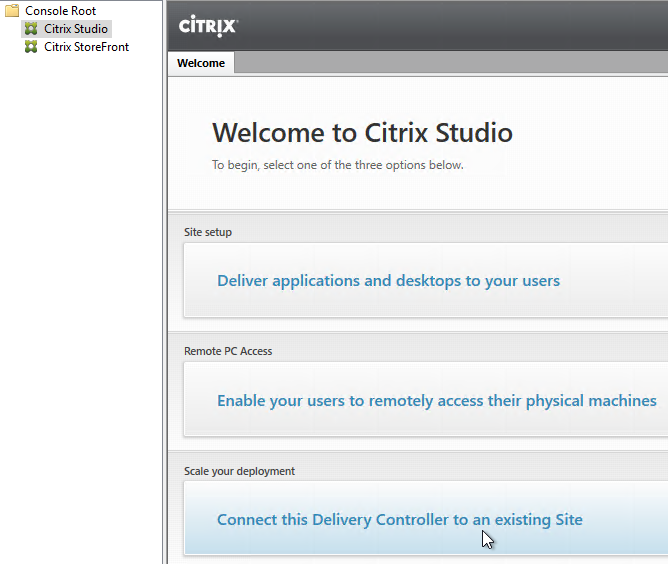
- Enter the name of the first Delivery Controller, and click OK.
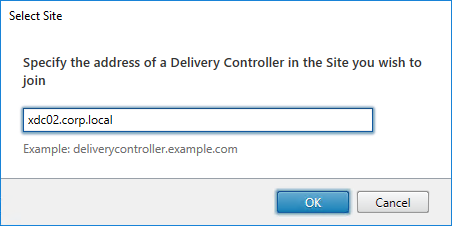
- If you don’t have elevated SQL permissions, click No when asked if you want to update the database automatically.

- Click Generate scripts.
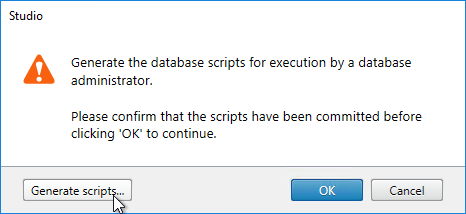
- A folder will open with six scripts. If not mirroring, then the top three scripts need to be sent to a DBA. If mirroring, send all six.
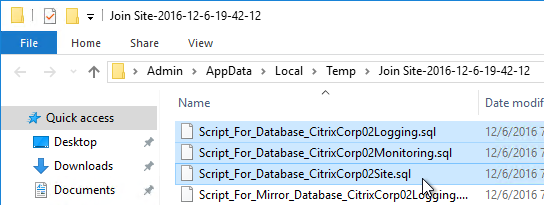
- On the SQL Server, open one of the .sql files.
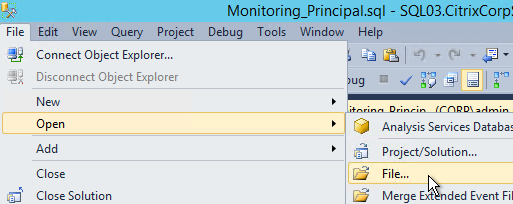
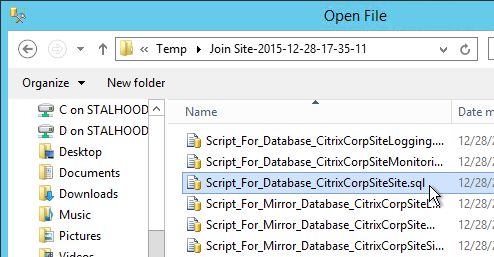
- Open the Query menu and click SQLCMD Mode.
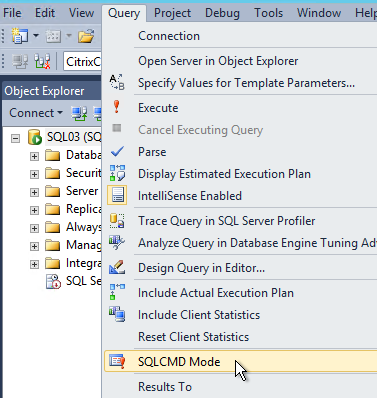
- Then execute the XenDesktop script.
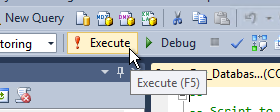
- If SQLCMD mode was enabled properly then the output should look something like this:
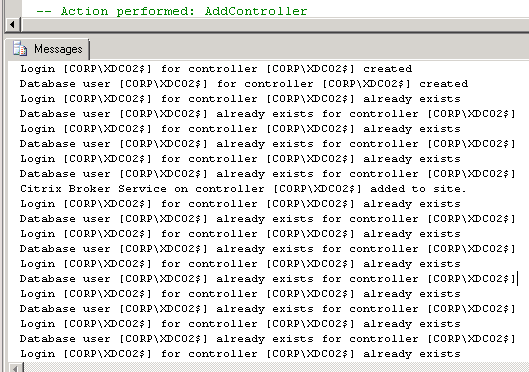
- Repeat for the remaining script files.
- Back in Citrix Studio, click OK.
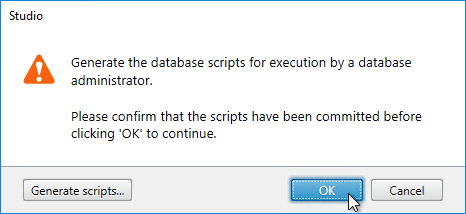
- In Citrix Studio, under Configuration > Controllers, you should see both controllers.
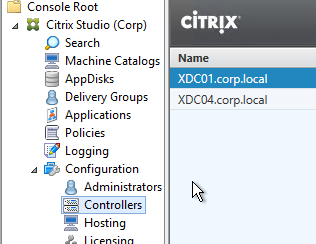
- You can also test the site again if desired.
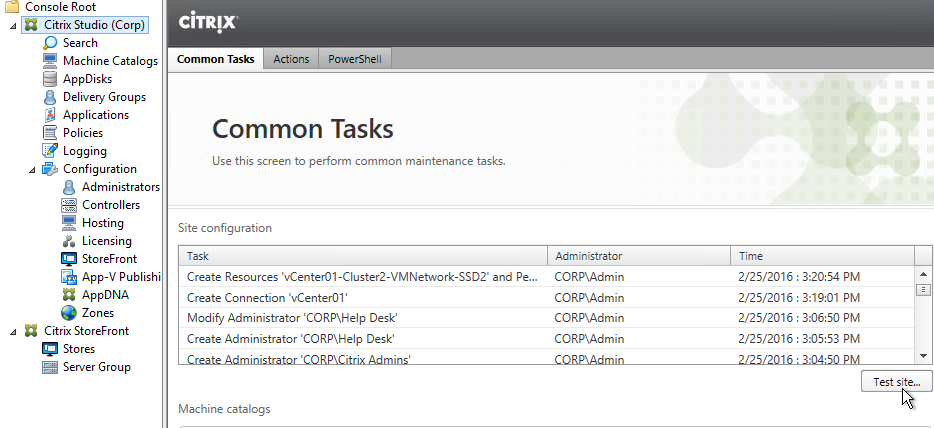
Studio – Slow Launch
From B.J.M. Groenhout at Citrix Discussions: The following adjustments can be made if Desktop Studio (and other Citrix management Consoles) will start slowly:
- Within Internet Explorer, go to Tools – Internet Options – Tab Advanced – Section Security and uncheck the option Check for publisher’s certificate revocation
After adjustment Desktop Studio (MMC) will be started immediately. Without adjustment it may take some time before Desktop Studio (MMC) is started.
Registry setting (can be deployed using Group Policy Preferences):
- HKEY_CURRENT_USER\Software\Microsoft\Windows\CurrentVersion\WinTrust\Trust Providers\Software Publishing
- “State“=dword:00023e00
Local Host Cache
If you have 5,000 or fewer VDAs, you can enable Local Host Cache (LHC) instead of Connection Leasing. LHC allows new sessions to be started even if SQL database is unavailable.
From Local Host Cache sizing and scaling at Citrix Docs:
- For LHC LocalDB, assign the Controller VMs a single socket with multiple cores.
- Add two cores for LHC.
- Add at least three more Gigs of RAM and watch the memory consumption.
- Since there’s no control over LHC election, ensure all Controllers have the same specs.
- The Docs article has scripts for monitoring LHC performance.
From XenApp 7.12, LHC and a reboot at Citrix Discussions:
- If the rebooted DDC is the elected one, a different DDC will take over (causing registration storm) and when the DDC gets back, it will take over brokering causing second registration storm. Site will sort itself out and all will work.
- If the rebooted DDC is not the elected one, it will not impact any functionality.
- If you turn the DDC down when site is working, and start it during outage, LHC will not trigger on that machine. This DDC will not impact the LHC unless it would become the elected one. In that scenario it will take control, however not start LHC and resources would not be available.
For Windows Server 2008 R2 Controllers, PowerShell 3, or newer, is required. See LHC XD 7.12 and W2K8SR2 SP1 at Citrix Discussions.
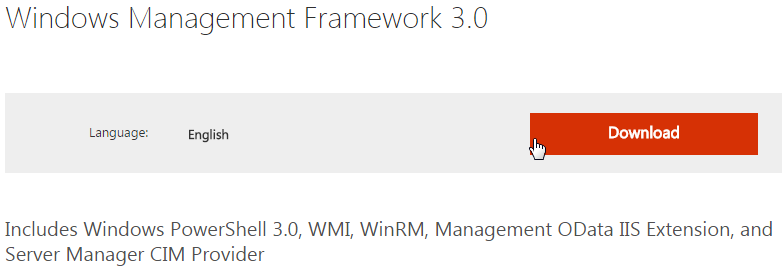
Local Host Cache can be enabled by running some PowerShell commands.
asnp citrix.* Set-BrokerSite -ConnectionLeasingEnabled $false Set-BrokerSite -LocalHostCacheEnabled $true

George Spiers Local Host Cache XenApp & XenDesktop 7.12 shows the Event Log entries when LHC is enabled.
Database Maintenance
Enable Read-Committed Snapshot
The XenDesktop Database can become heavily utilized under load in a large environment. Therefore Citrix recommends enabling the Read_Committed_Snapshot option on the XenDesktop databases to remove contention on the database from read queries. This can improve the interactivity of Studio and Director. It should be noted that this option may increase the load on the tempdb files. See Citrix article CTX137161 How to Enable Read-Committed Snapshot in XenDesktop for configuration instructions.
Change Database Connection Strings
Sometimes the database connection strings need to be modified:
- When moving the SQL databases to a different SQL server
- For AlwaysOn Availability Groups, to add MultiSubnetFailover to the SQL connection strings
- For SQL mirroring, to add Failover Partner to the SQL connection strings
CTX140319 How to Migrate XenDesktop Database to New SQL Server has the correctly ordered list of PowerShell commands to change the database connection strings. Make sure PowerShell is running as administrator before running these commands.
Here are the DB Connections that must be changed. This list might be longer than the article. When using the article, make sure you include all of the DB Connections shown below. You can get the full list of database commands by running Get-Command Set-*DBConnection. When changing the DB connections, AdminDBConnection must be the last to be set to NULL, and the first to be configured with the new connection string.
Set-ConfigDBConnection -DBConnection $null Set-AppLibDBConnection –DBConnection $null #7.8 and newer Set-OrchDBConnection –DBConnection $null #7.11 and newer Set-TrustDBConnection –DBConnection $null #7.11 and newer Set-AcctDBConnection -DBConnection $null Set-AnalyticsDBConnection -DBConnection $null Set-HypDBConnection -DBConnection $null Set-ProvDBConnection -DBConnection $null Set-BrokerDBConnection -DBConnection $null Set-EnvTestDBConnection -DBConnection $null Set-SfDBConnection -DBConnection $null Set-MonitorDBConnection -DataStore Monitor -DBConnection $null #Monitoring Database Set-MonitorDBConnection -DBConnection $null #Site Database Set-LogDBConnection -DataStore Logging -DBConnection $null #Logging Database Set-LogDBConnection -DBConnection $null #Site Database Set-AdminDBConnection -DBConnection $null -force
Citrix CTX221389 Scripts For Updating Connection Strings in XenApp/XenDesktop 7.x was recently updated for 7.13.
- Change_XD_Failover_Partner_v1.ps1 – is used to update the mirroring failover partner.
- Change_XD_To_ConnectionString.ps1 – this takes passed in connection strings and uses them, so a very generic version.
- Change_XD_To_MultiSubnetFailover.ps1 – this toggles the MultiSubnetFailover. If it doesn’t exist or is false, it sets it to true. If it’s set to true, the script sets it back to false. If you need to remove the option then you’ll need to use Change_XD_To_ConnectionString.ps1 and provide strings without the setting.
- Change_XD_To_Null.ps1 – this is a reset of all the connection strings on the localhost as something has gone wrong. Note because this resets the connection strings to null, it will actually place the ddc into a “initial” state. I.E. if you run Studio, it’ll ask if you want to create a site, or join to another DDC. This is useful if something has gone wrong, as you can reset a Controller’s settings, and then attempt to set the connection strings again using Change_XD_To_ConnectionString.ps1.
Director Grooming
If XenDesktop is not Platinum Edition, then all historical Director data is groomed at 30 days.
For XenDesktop/XenApp Platinum Edition, by default, most of the historical Director data is groomed at 90 days. This can be adjusted up to 367 days by running a PowerShell cmdlet.
- On a Delivery Controller, run PowerShell and run asnp Citrix.*

- Run Get-MonitorConfiguration to see the current grooming settings.
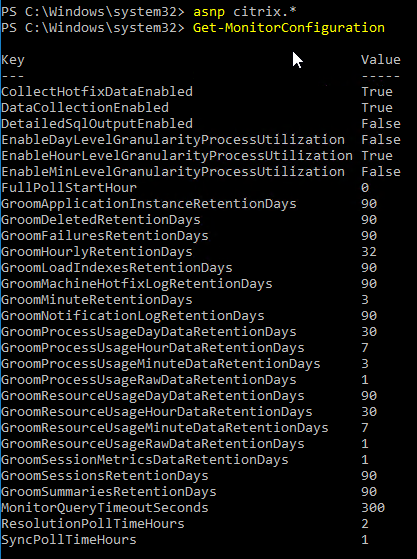
- Run Set-MonitorConfiguration to change the grooming settings.
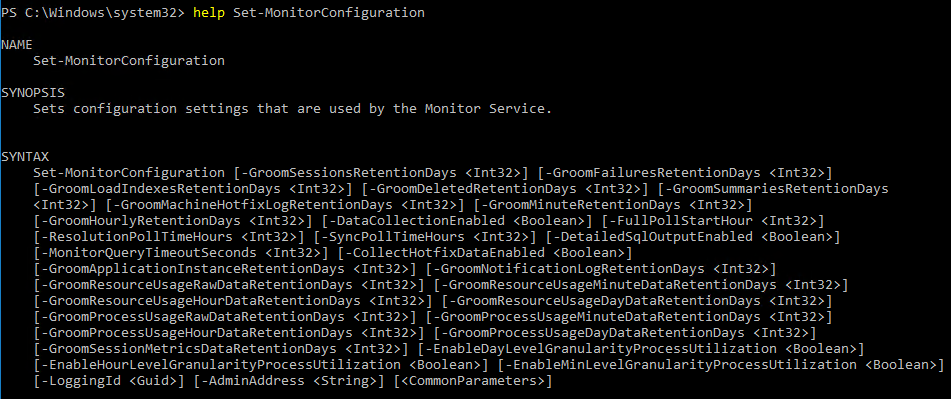
View Logging Database
To view the contents of the Logging Database, in Studio, click the Logging node. On the right is Create Custom Report. See Citrix article CTX138132 Viewing Configuration Logging Data Not Shown for more info.
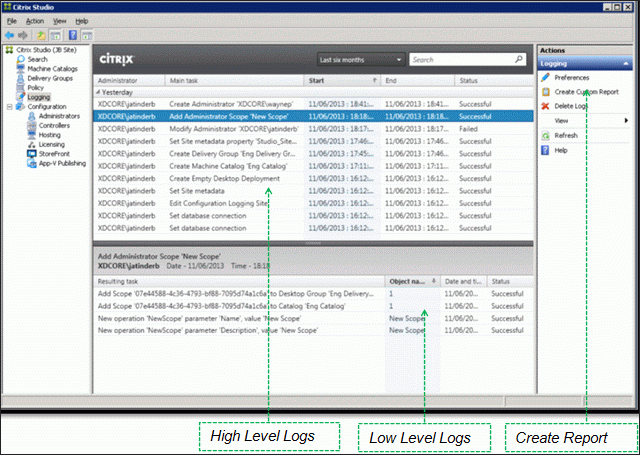
The Logging Database can be queried using Get-LogLowLevelOperation. See Stefan Beckmann Get user who set maintenance mode for a server or client for an example script that uses this PowerShell cmdlet.
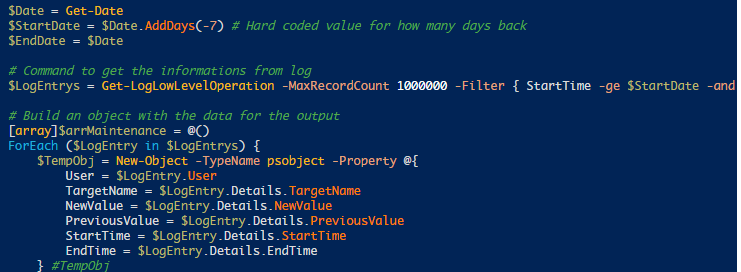
Maintain Logging Database
Citrix CTX215069 Troubleshooting and managing Oversized Configuration Logging database: The article’s queries can be used to determine the number of configuration operation types performed by XenDesktop Administrator, and to analyze the content of the Configuration Logging database when it is considered oversized. A grooming query is also provided to delete data older than a specified date.
Export/Import Configuration
Ryan Butler has a PowerShell script that can export configuration from one XenDesktop farm and import it to another.
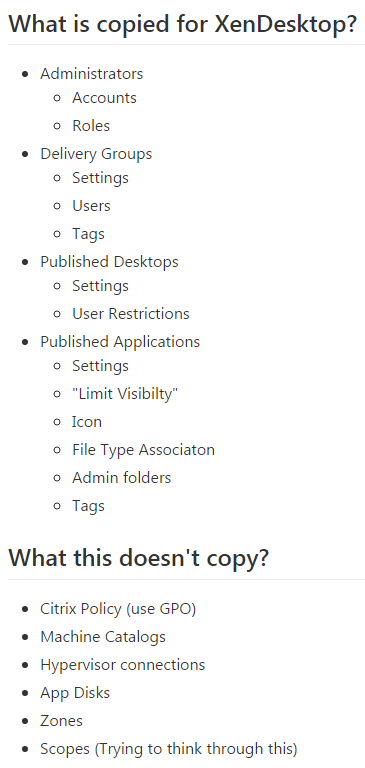
Studio Administrators
Full Administrators
- In the Studio, under Configuration, click the Administrators node. The first time you access the node you’ll see a Welcome page. Feel free to check the box to Don’t show this again, and then click Close.
- On the Administrators tab, right-click, and click Create Administrator.
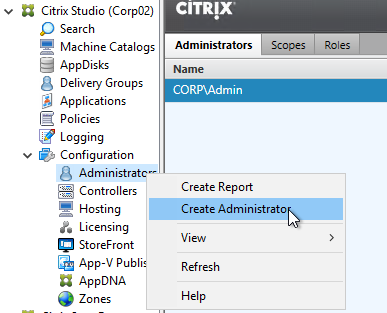
- In the Administrator and Scope page, Browse to a group (e.g. Citrix Admins) that will have permissions to Studio and Director. These groups typically have access to all objects so select the All scope. Alternatively, you can create a Scope to limit the objects. Click Next.
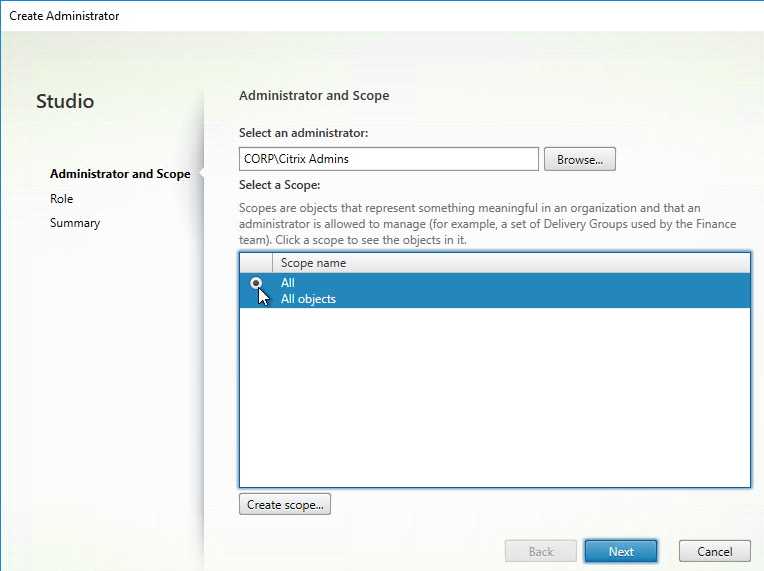
- On the Role page, select a role, and then click Next. For example:
- Full Administrator for the Citrix Admins group
- Help Desk Administrator for the Help Desk group
- Machine Catalog Administrator for the desktop team
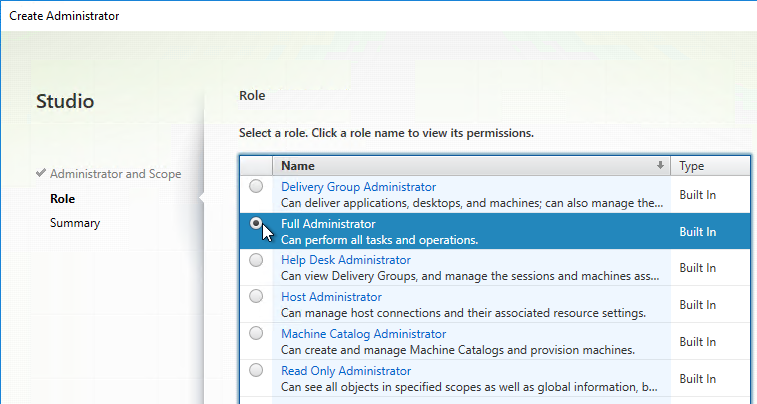
- In the Summary page, click Finish.
Help Desk
- In the Studio, under Configuration, click the Administrators node. On the Administrators tab, right-click, and click Create Administrator.
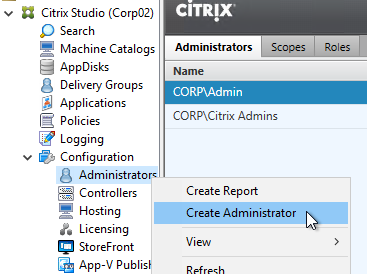
- In the Administrator and Scope page, Browse to a Help Desk group that will have permissions to Studio and Director. Select the All scope. And click Next.
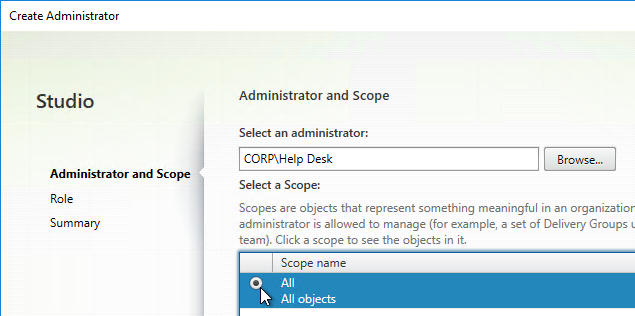
- On the Role page, select the Help Desk Administrator role, and then click Next.
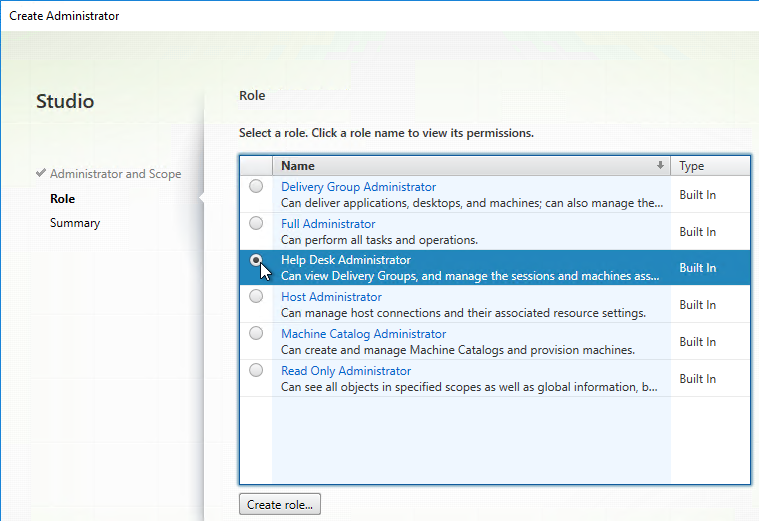
- In the Summary page, click Finish.
- When administrators in the Help Desk role log into Director, all they see is this.

To jazz it up a little, add the Help Desk group to the read-only role. - Right-click the Help Desk Administrator, and click Edit Administrator.
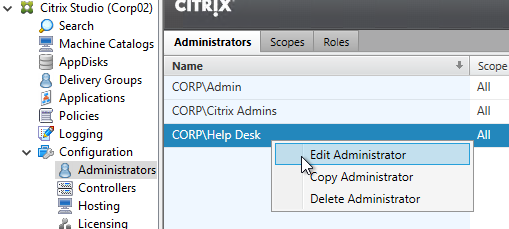
- Click Add.
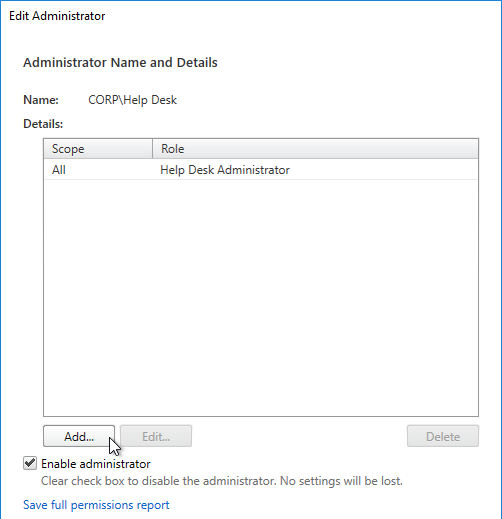
- In the Scope page, select a scope, and click Next.
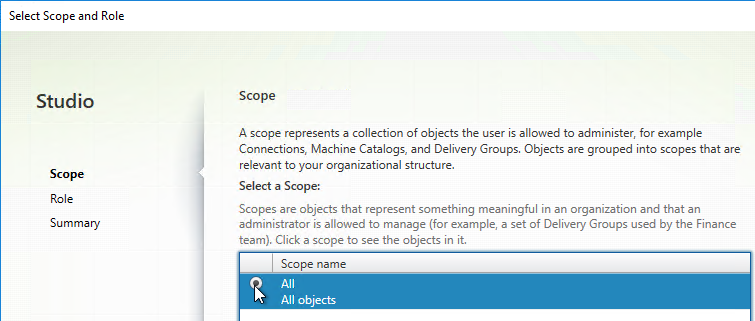
- In the Role page, select Read Only Administrator, and click Next.
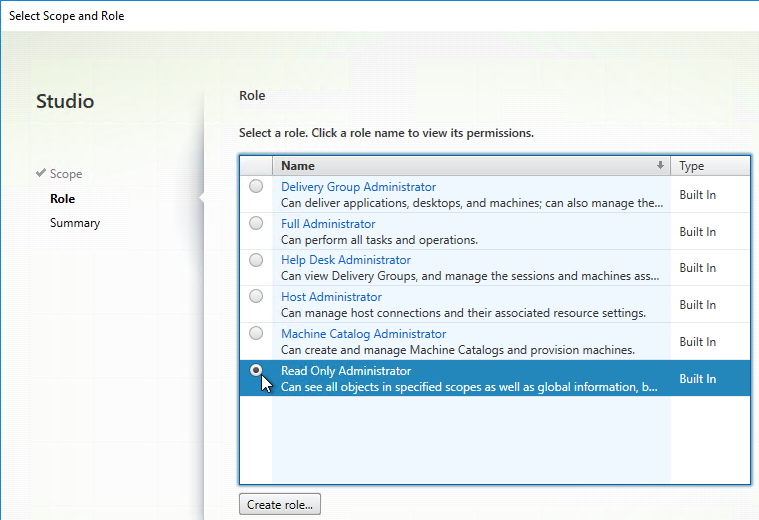
- In the Summary page, click Finish.
- Then click OK. Now Director will display the dashboard.
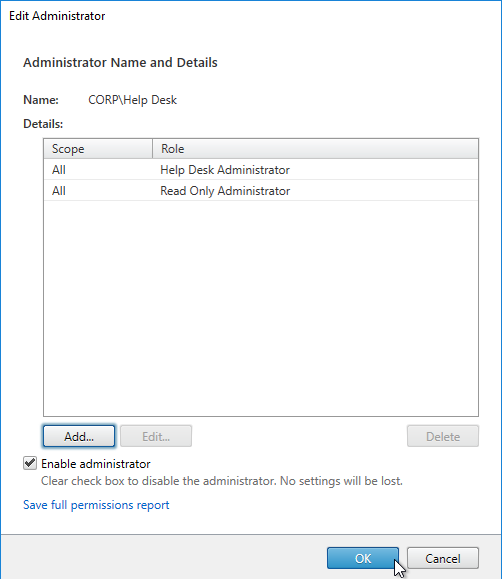
Provisioning Services w/Personal vDisk
From Considerations: Provisioning Services at Configure and manage Personal vDisk at Citrix Docs: The Provisioning Services Soap Service account must be added to the Administrator node of Studio and must have the Machine Administrator or higher role. This ensures that the PvD desktops are put into the Preparing state when the Provisioning Services (PVS) vDisk is promoted to production.
Customer Experience Improvement Program
XenApp/XenDesktop 7.13 enables CEIP by default. If desired, you can disable it in Citrix Studio:
- On the left, go to the Configuration node.
- On the right, switch to the Product Support tab.
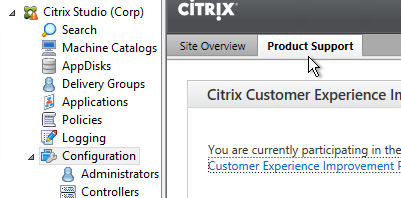
- Click End.
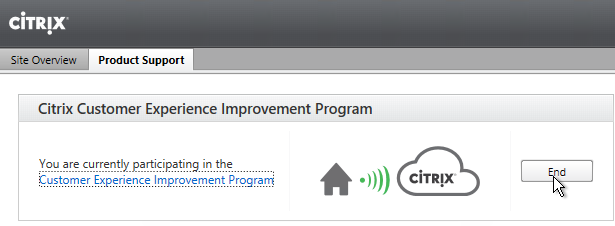
- Click Yes.
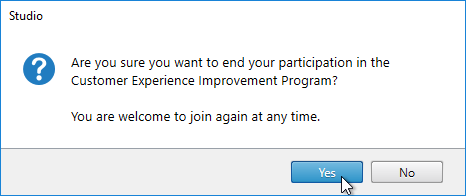
Each XenApp/XenDesktop component has a separate configuration for disabling Customer Experience Improvement Program:
- License Server CEIP
- Virtual Delivery Agent CEIP
- Profile Management CEIP
- StoreFront CEIP
- Provisioning Services CEIP
- Receiver CEIP
- Receiver for HTML5 CEIP 💡
- Session Recording CEIP
- AppDNA CEIP
- NetScaler CEIP
vCenter Connection
XenDesktop uses an Active Directory service account to log into vCenter. This account needs specific permissions in vCenter. To facilitate assigning these permissions, create a new vCenter role and assign it to the XenDesktop service account. The permissions should be applied at the datacenter or higher level.
Hosting Resources
A Hosting Resource = vCenter + Cluster (Resource Pool) + Storage + Network. When you create a machine catalog, you select a previously defined Hosting Resource, and the Cluster, Storage, and Network defined in the Hosting Resource object are automatically selected. If you need some desktops on a different Cluster+Storage+Network then you’ll need to define more Hosting Resources in Studio.
- In Studio, expand Configuration and click Hosting. Right-click it, and click Add Connection and Resources.
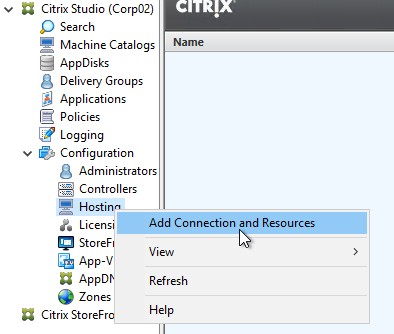
- In the Connection page, for Connection type, select VMware vSphere.
- Notice there’s a Learn about user permissions blue link to an article that describes the necessary permissions.
- Enter https://vcenter01.corp.local/sdk as the vCenter URL. The URL must contain the FQDN of the vCenter server.
- Enter credentials of a service account that can log into vCenter.
- In the Connection name field, give the connection a name. Typically, this matches the name of the vCenter server.
- If you are not using Machine Creation Services, and instead only need the vCenter connection for machine power management, change the Create virtual machines using selection to Other Tools. If you intend to use MCS, leave it set to Studio Tools.
- Click Next.
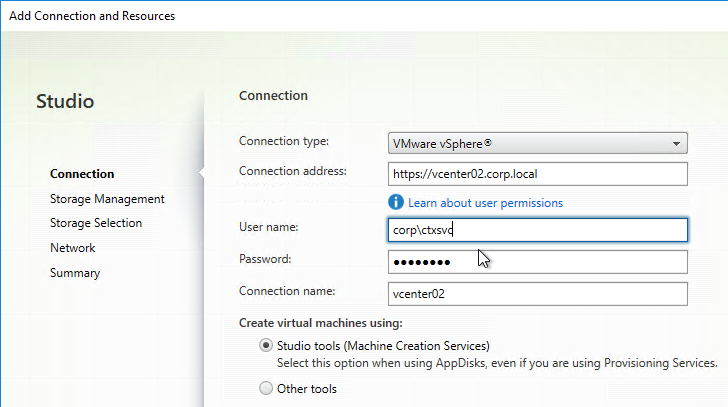
- If you see a message about the vCenter certificate, check the box next to Trust certificate, and click OK.
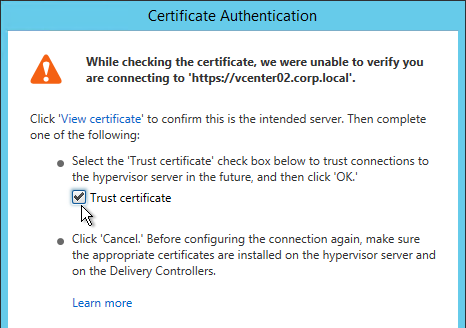
- Note: this vCenter certificate thumbprint is stored in the XenDesktop database, and is not updated when the vCenter certificate changes. See CTX217415 Cannot connect to the VCenter server due to a certificate error for instructions on manually updating the database with the new certificate thumbprint.
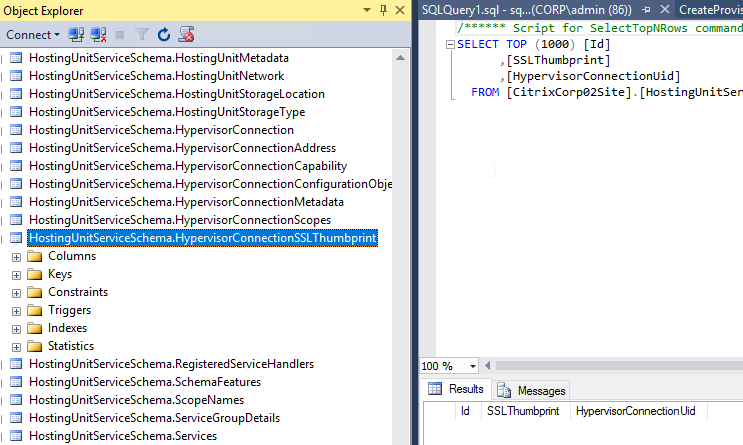
- In the Storage Management page, click Browse, and select a vSphere cluster. Note: as detailed at CTX223662, make sure there’s no comma in the datacenter name.
- Select Use storage shared by hypervisors.
- If you have sufficient disk space on each ESXi host, also select Optimize temporary data on available local storage. From Mark Syms at XA 7.9 MCS with RAM Caching at Citrix Discussions: “If you use just MCS caching to local storage then the VM is not agile at all and cannot be moved even when powered off as it has a virtual disk permanently associated with a single host.”
- From Martin Rowan at XA 7.9 MCS with RAM Caching at Citrix Discussions: for the temporary cache disk, “Don’t format it, the raw disk is what MCS caching uses.”
- Click Next.
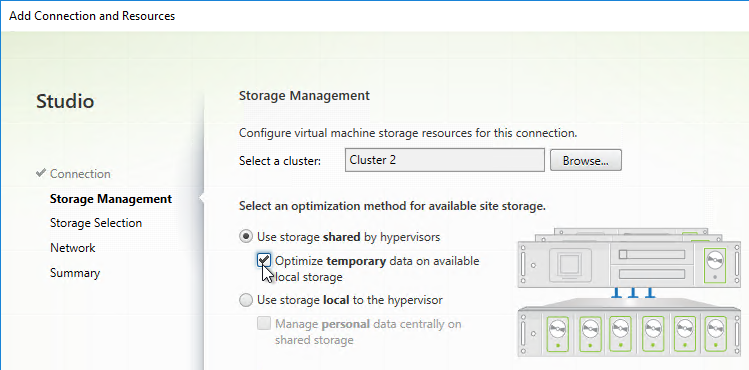
- In the Storage Selection page, OS and Personal vDisk must be selected on at least one datastore. For maximum flexibility, only select one datastore. To select additional datastores, run this wizard again to create a separate Hosting Resource.
- If you selected the temporary data on local storage option, on the bottom, click Select, and choose the datastores you want to use for disk caching. By default, all local datastores are selected. Click Next when done.
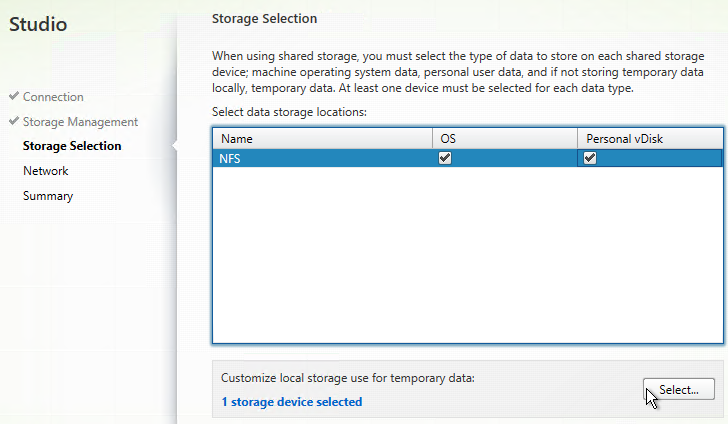
- In the Network page, enter a name for the hosting resource. Since each hosting resource is a combination of vCenter, Cluster, Network, and Datastores, include those names in this field (e.g. vCenter01-Cluster01-Network01-Datastore01).
- Select a network and click Next.
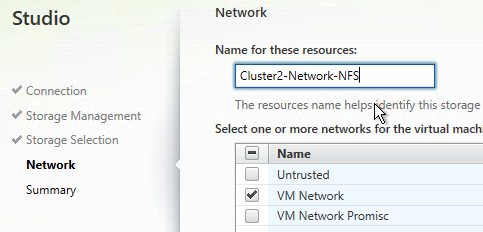
- In the Summary page, click Finish.
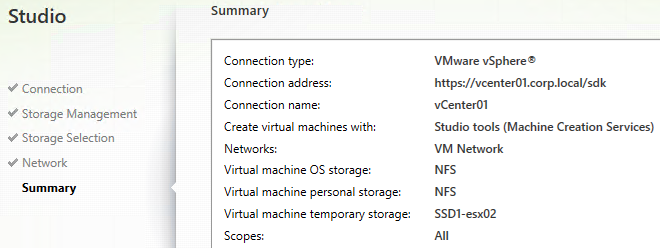
- If you have multiple datastores for your VDAs, run the wizard again.
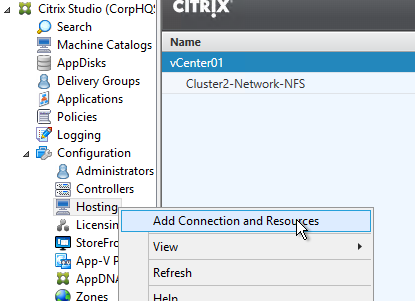
- You can use the existing vCenter connection.
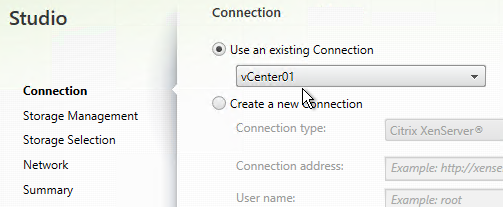
- This time, select a different datastore.
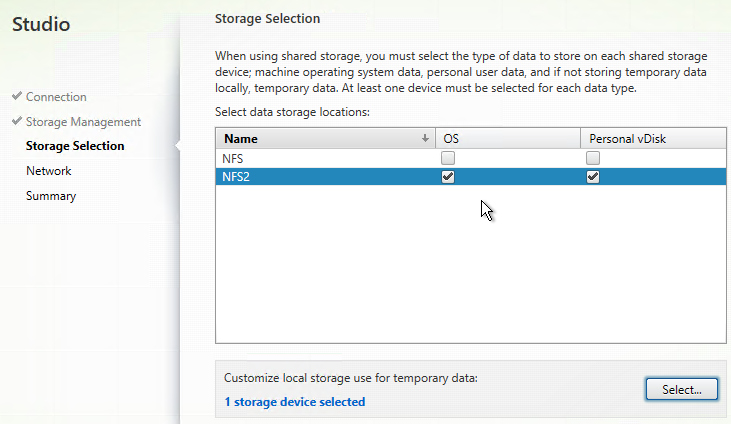
- Give it a name that indicates the chosen datastore.
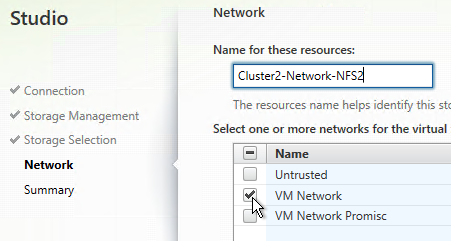
- When you create a Catalog, select the Hosting Resource for the datastore where you want the VDAs to be placed. Create additional Catalogs for each datastore. You can then combine the Catalogs into a single Delivery Group.
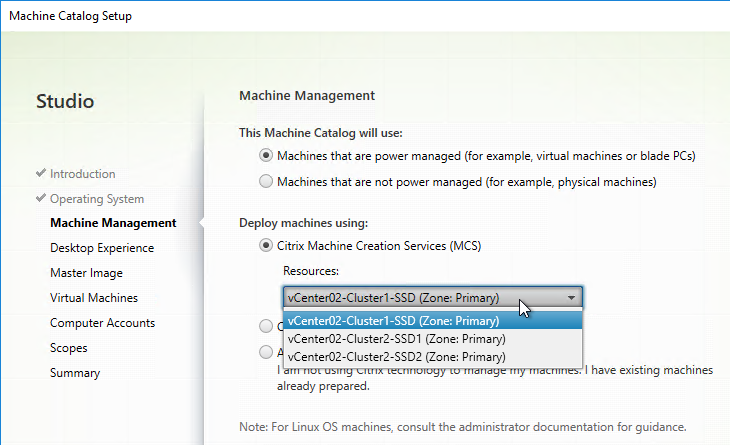
- Later in the Catalog wizard, you’re given an option to enable caching and select a cache size. This is similar to Provisioning Services option “Cache in RAM with overflow to disk”.
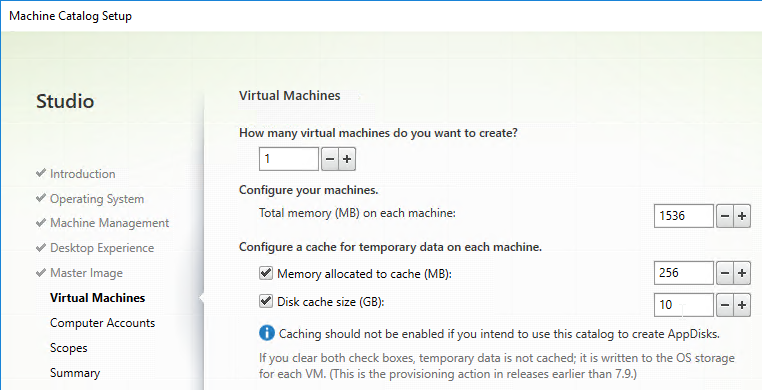
Citrix Licensing Server
Upgrade
XenApp/XenDesktop 7.13 comes with 11.14.0.1 build 19005
If you have a standalone Licensing Server, upgrade it to Citrix Licensing 11.14.0.1 build 19005 if it isn’t already.
- Go to the downloaded Citrix Licensing 11.14.0.1 build 19005 and run CitrixLicensing.exe.

- If you see the Subscription Advantage Renewal page, make a selection, and click Next.
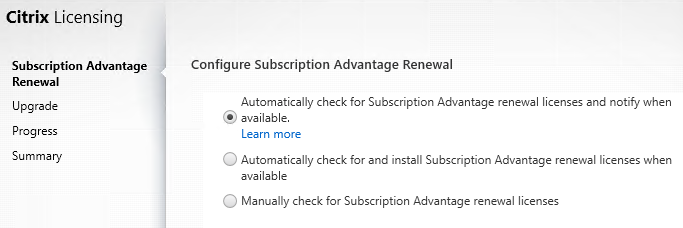
- In the Upgrade page, click Upgrade.
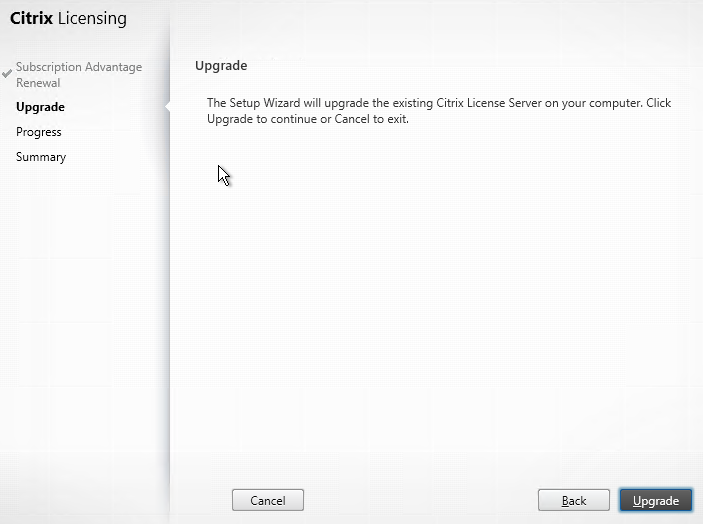
- Click Finish.
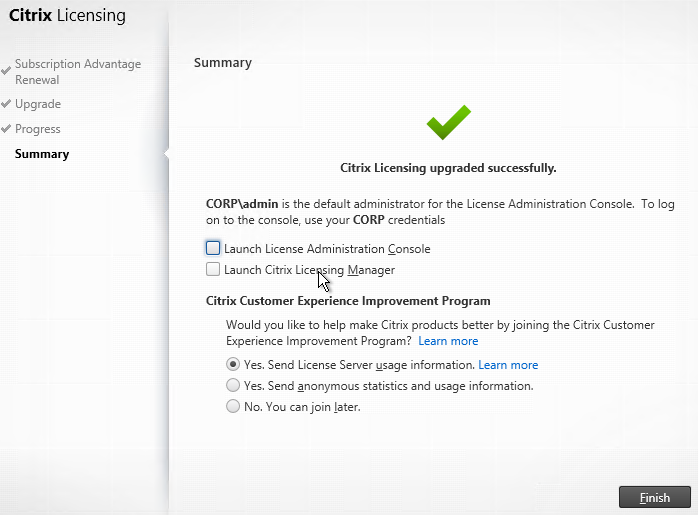
- If you go to Programs and Features, it should now show version 13.0.0.19005.
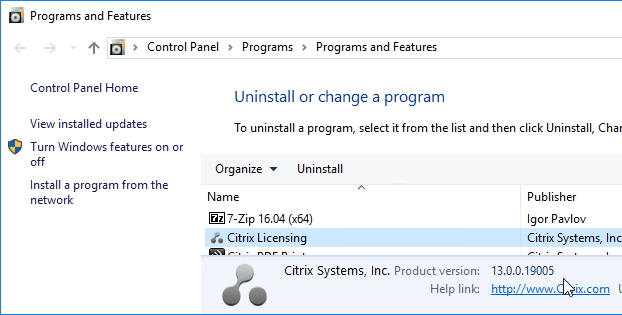
- If you login to the license server web console, on the Administration tab, it shows it as version 11.14.0 build 18001.
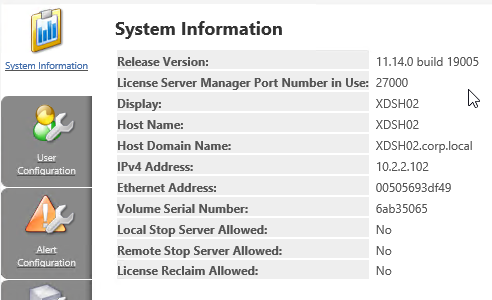
- You can also view the version in the registry at HKLM\Software\Wow6432Node\Citrix\LicenseServer\Install.
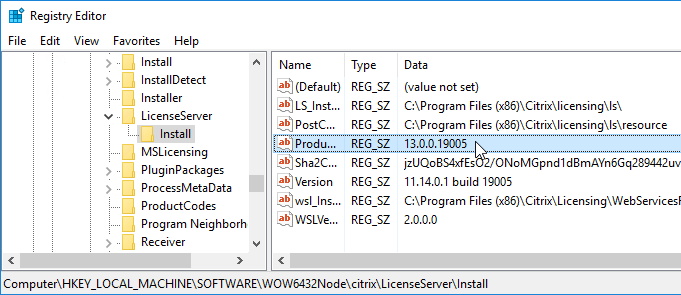
License Server CEIP
11.14.0.1 build 19005 and newer enables CEIP by default. This can be disabled in the Citrix Licensing Manager (https://localhost:8083) by clicking the gear icon.

Scroll down to Share usage statistics with Citrix and make a selection.
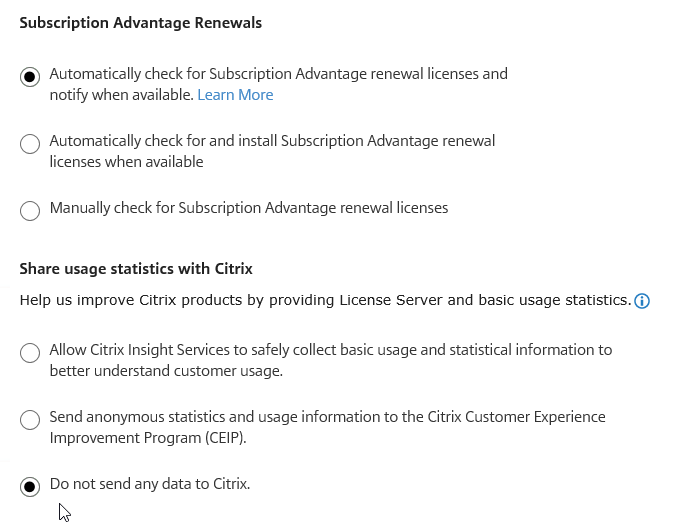
Citrix License Management Service
New in 11.14.0.1 is the Citrix License Management Service. This service helps you avoid prohibited practices:
- Duplication of licenses outside a Disaster Recovery (DR) environment
- Use of legacy licenses for new product versions
- Use of rescinded licenses
Licensing Server HA using GSLB
From Dane Young – Creating a Bulletproof Citrix Licensing Server Infrastructure using NetScaler Global Server Load Balancing (GSLB) and CtxLicChk.ps1 PowerShell Scripts. Here is a summary of the configuration steps. See the blog post for detailed configuration instructions.
- Build two License Servers in each datacenter with identical server names. Since server names are identical, they can’t be domain-joined.
- Install identical licenses on all License Servers.
- Set the DisableStrictNameChecking registry key on all Citrix Licensing servers.
- Synchronize the certificate files located at C:\Program Files (x86)\Citrix\Licensing\WebServicesForLicensing\Apache\conf. They must be identical on all Licensing Servers.
- Download CtxLicChk.exe from http://support.citrix.com/article/CTX123935 and place on all Licensing Servers.
- Schedule the PowerShell script CtxLicChk.ps1 on all Licensing Servers. Get this script from the blog post linked above.
- Configure NetScaler:
- Configure GSLB ADNS services.
- Add wildcard Load Balancing service for each Citrix Licensing Server.
- Configure service TCP monitoring for ports 27000, 7279, 8082, and 8083.
- Create Load Balancing Virtual Server for each Licensing Server.
- Set one Load Balancing Virtual Server as backup for the other.
- Repeat in second datacenter.
- Configure GSLB Services and GSLB Monitoring.
- Configure GSLB Virtual Servers. Set one GSLB Virtual Server as backup for the other.
- Delegate the Citrix Licensing DNS name to the ADNS services on the NetScaler appliances.
- Configure Citrix Studio to point to the GSLB-enabled DNS name for Citrix Licensing.
Citrix License Server Monitoring
Citrix Licensing 11.13.1 and newer has historical usage reporting:
- Run Citrix Licensing Manager from the Start Menu. Or use a browser to connect to https://MyLicenseServer:8083
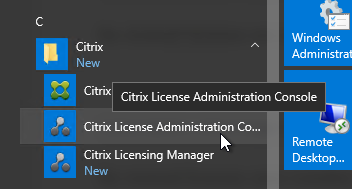
- Use the drop-down menus to select a license type, select dates, and export to a .csv file.
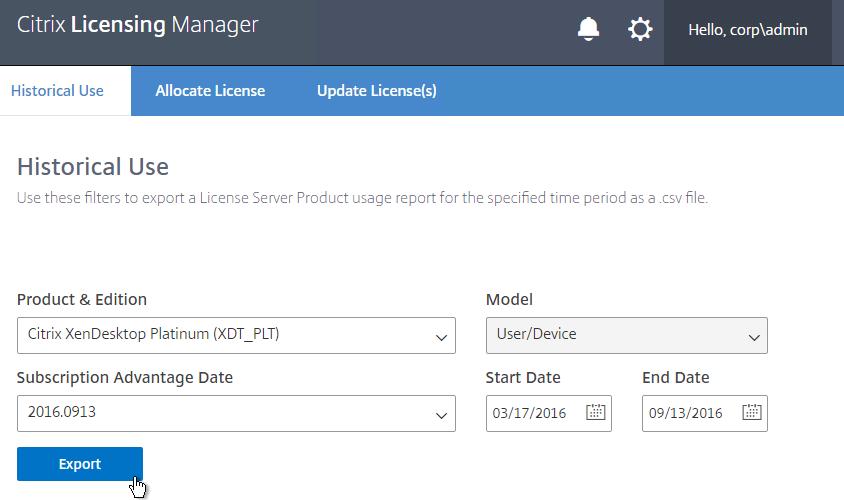
- The Update Licenses tab lets you check for renewals and download them.
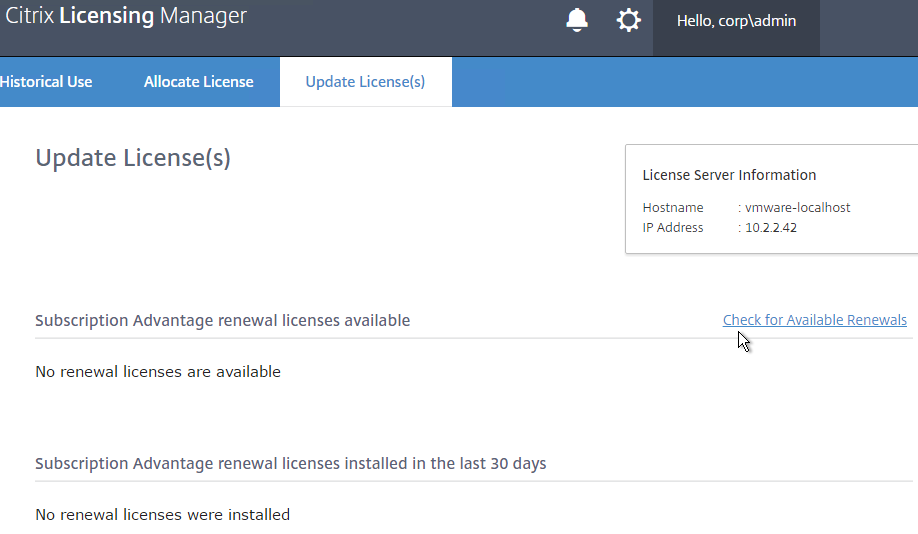
- On the top right is a gear icon where you can set the historical retention period and configure SA license auto-renewal.
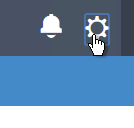
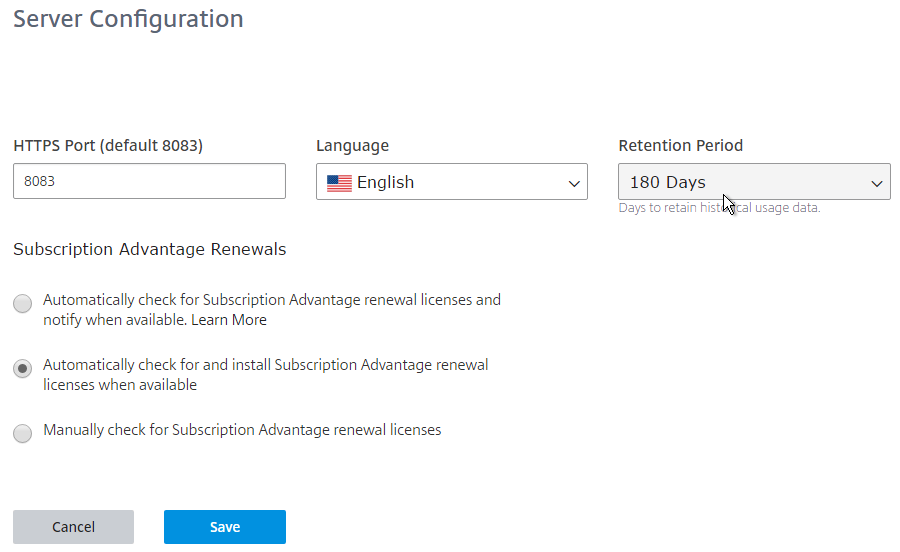
Jonathan Medd Monitor Citrix License Usage With PowerShell.
Lal Mohan – Citrix License Usage Monitoring Using Powershell
Jaroslaw Sobel – Monitoring Citrix Licenses usage – Graphs using WMI, Powershell and RRDtool. This script generates a graph similar to the following:
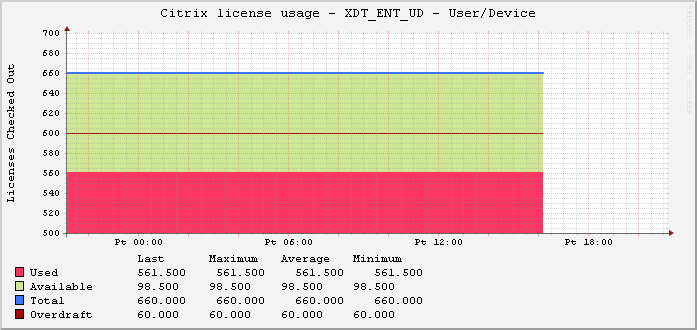
Remote Desktop Licensing Server
Install Remote Desktop Licensing Server
Do the following on your XenDesktop Controllers:
- In Server Manager, open the Manage menu, and click Add Roles and Features.
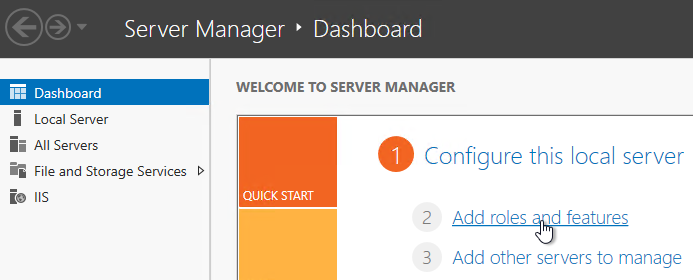
- In the Installation Type page, select Role-based or feature-based installation.
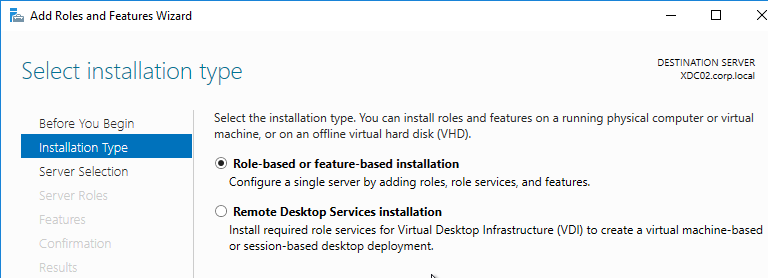
- Click Next until you get to the Server Roles page. Check the box next to Remote Desktop Services, and click Next.
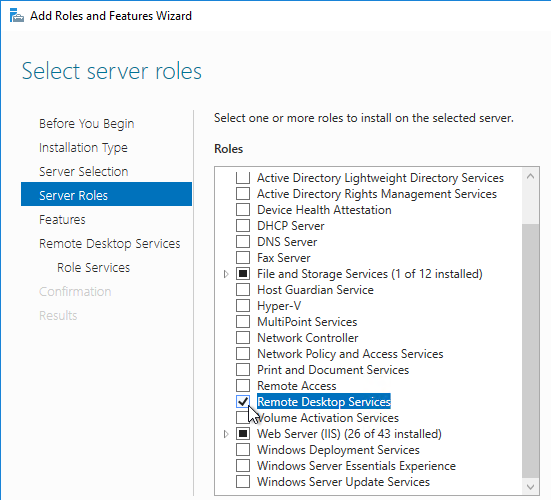
- Click Next until you get to the Role Services page. Check the box next to Remote Desktop Licensing, and click Next.
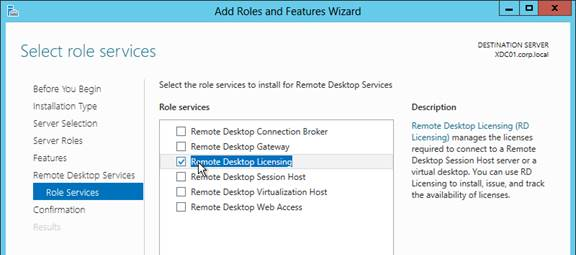
- Click Add Features if prompted.
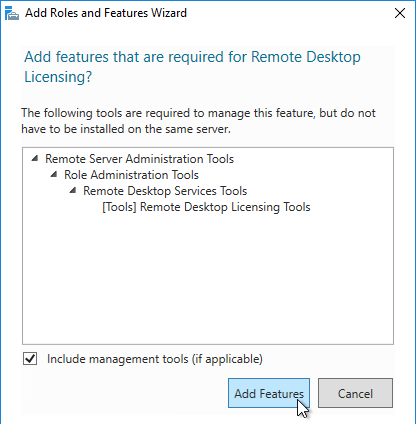
- Then finish the wizard to install the role service.
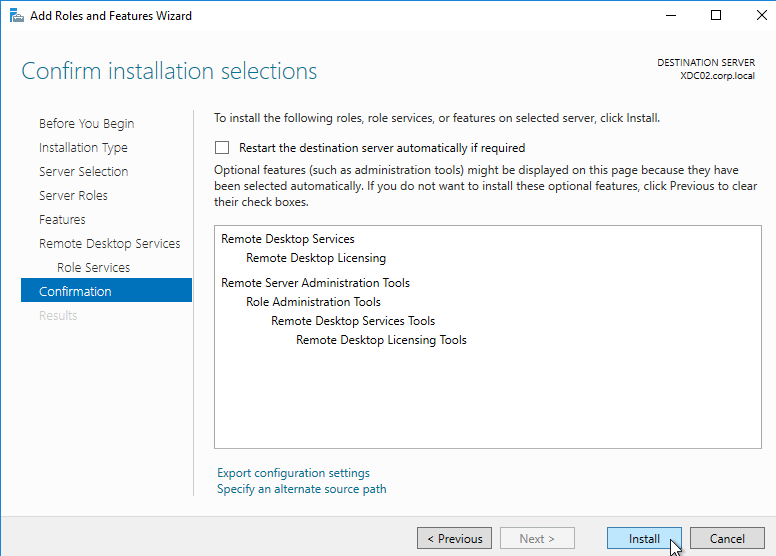
Activate Remote Desktop Licensing
- After RD Licensing is installed, in Server Manager, open the Tool menu, expand Terminal Services (or Remote Desktop Services), and click Remote Desktop Licensing Manager.
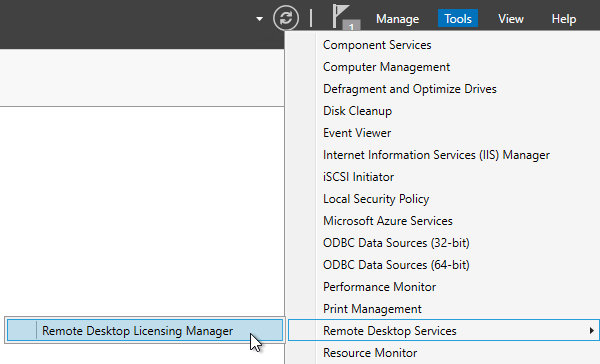
- The tool should find the local server. If it does not, right-click All servers, click Connect, and type in the name of the local server.
- Once the local server can be seen in the list, right-click the server and click Activate Server.
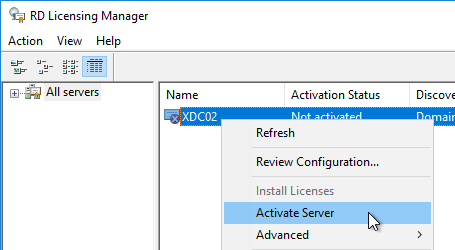
- In the Welcome to the Activate Server Wizard page, click Next.
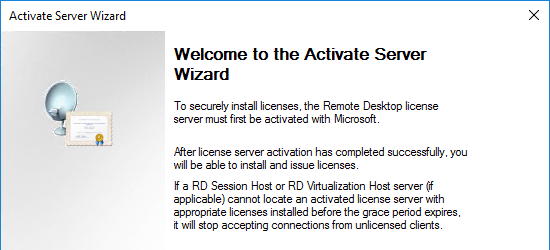
- In the Connection Method page, click Next.
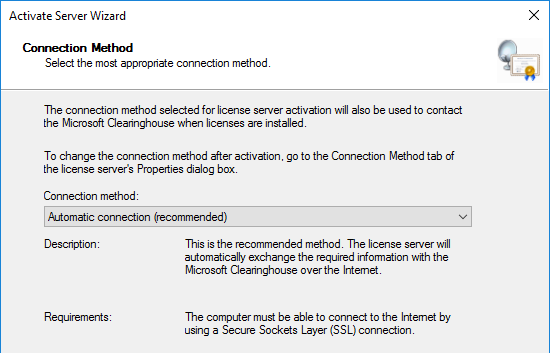
- In the Company Information page, enter the required information, and click Next.
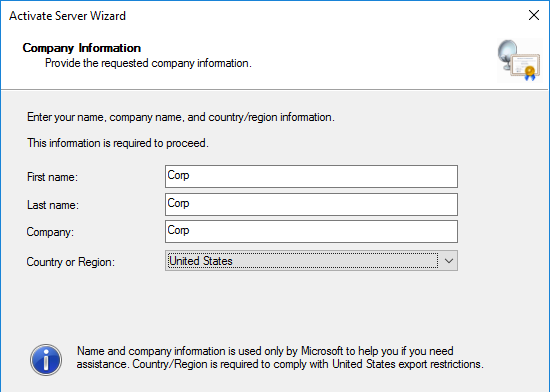
- All of the fields on the Company Information page are optional, so you do not have to enter anything. Click Next.
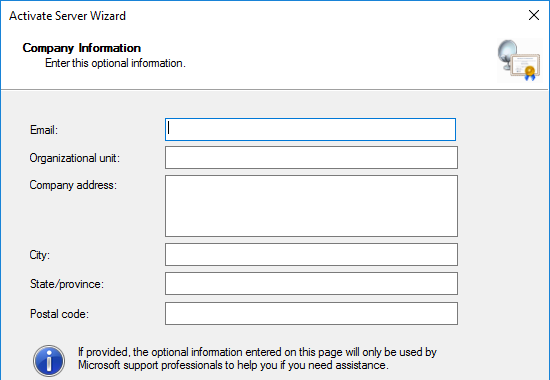
- In the Completing the Activate Server Wizard page, uncheck the box next to Start Install Licenses Wizard now, and click Finish. Since the session hosts will be configured to pull Per User licenses, there is no need to install licenses on the RD Licensing Server.
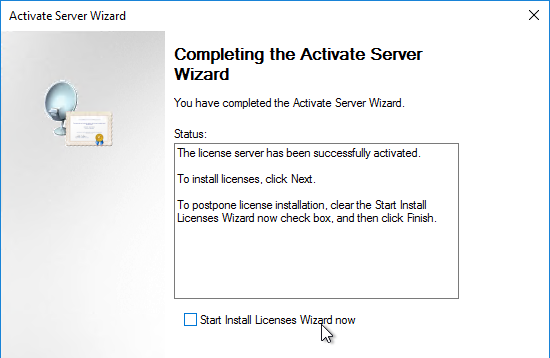
- In RD Licensing Manager, right-click the server, and click Review Configuration.
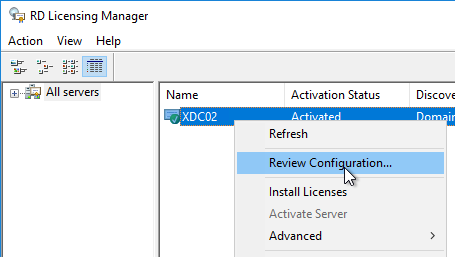
- Ensure you have green check marks. If the person installing Remote Desktop Licensing does not have permissions to add the server to the Terminal Server License Servers group in Active Directory, ask a domain admin to do it manually. If you have the proper permissions, click Add to Group.
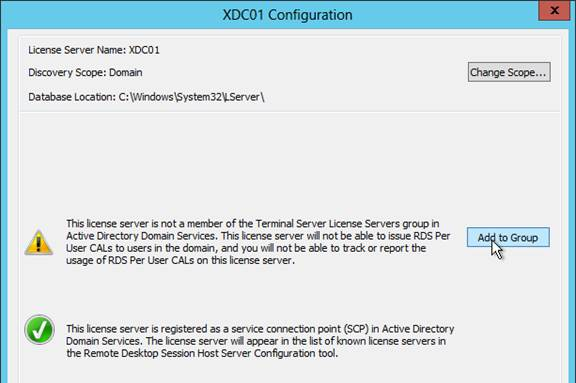
- Click Continue when prompted that you must have Domain Admins privileges.
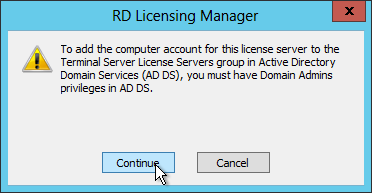
- Click OK when prompted that the computer account has been added.
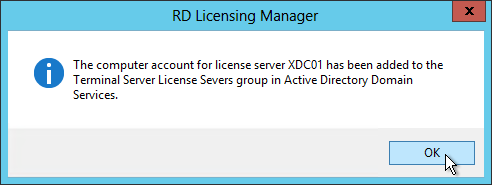
- Click OK to close the window.
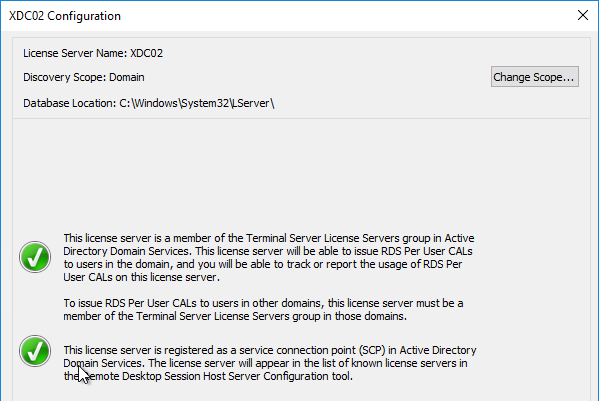
Smart Check
Citrix Cloud offers a Smart Check service that can scan your XenApp/XenDesktop infrastructure for known issues. Soon Smart Check will require Citrix Customer Success Services (Select).
- For a list of checks, see About health checks at Citrix Docs.
- For a comparison of Smart Check and Citrix Insight Services, see Citrix Blog Post What Data is Smart Check Collecting? 💡
To run Smart Check:
- Go to https://citrix.cloud.com, and login.
- After logging in, find Smart Tools, and click Manage.
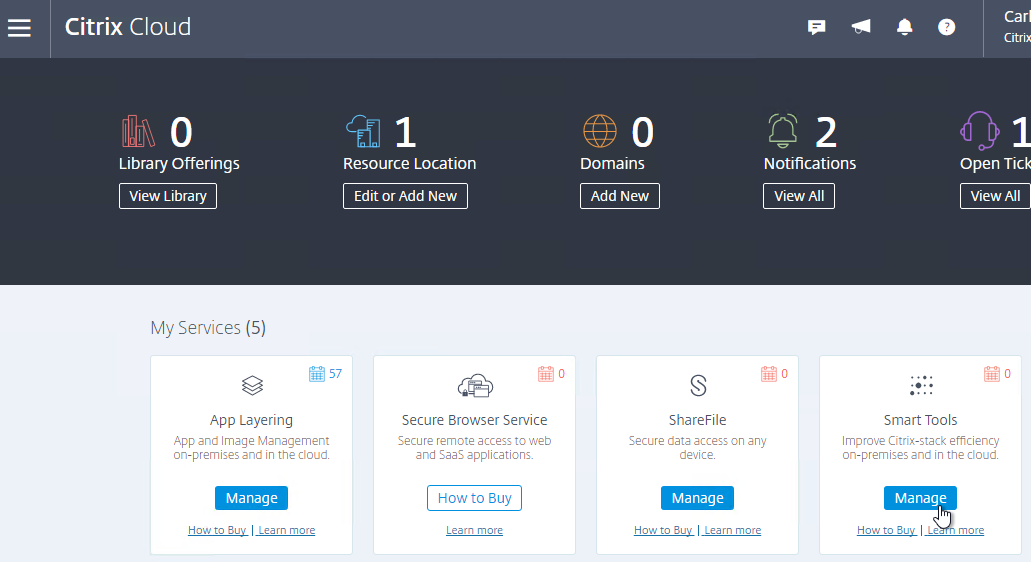
- Click Smart Check.
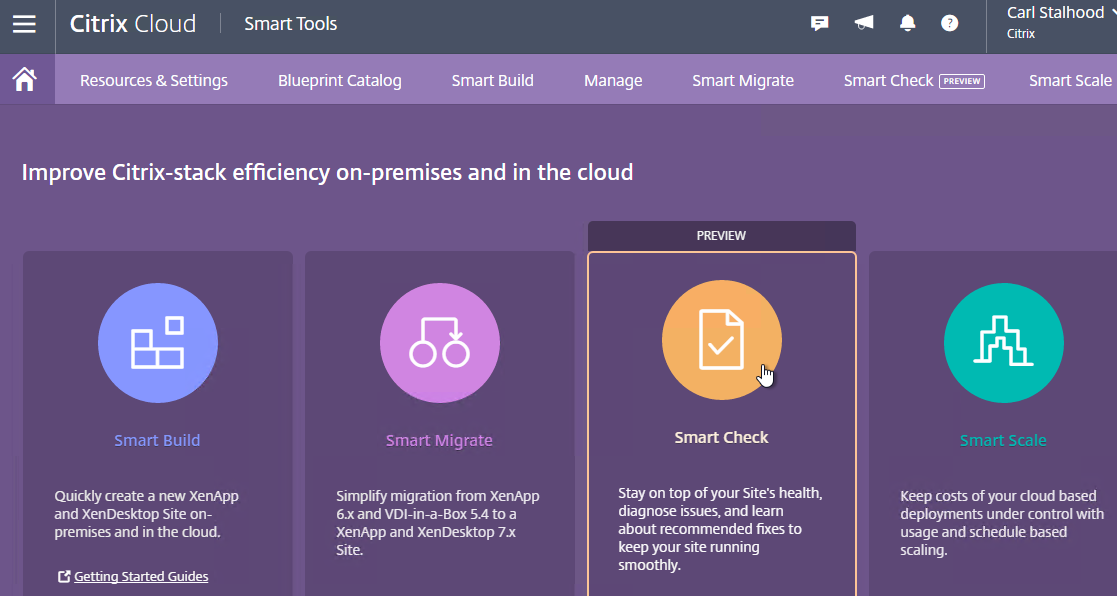
- On the top right, click Add Site.
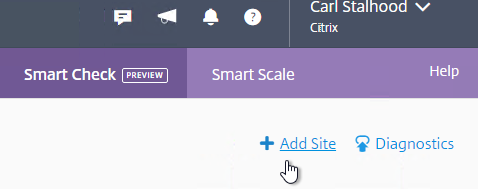
- In step 1, click Download Agent.
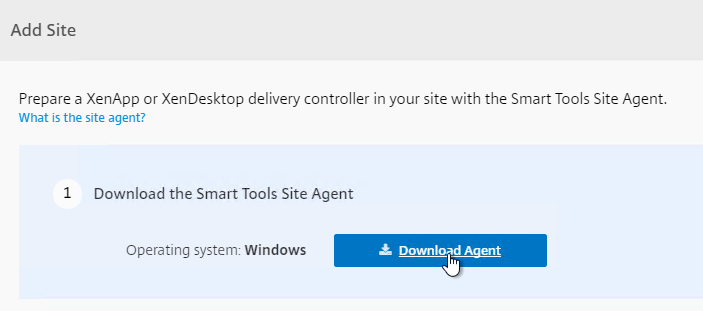
- Step 2 indicates it is waiting for you to install the Agent.
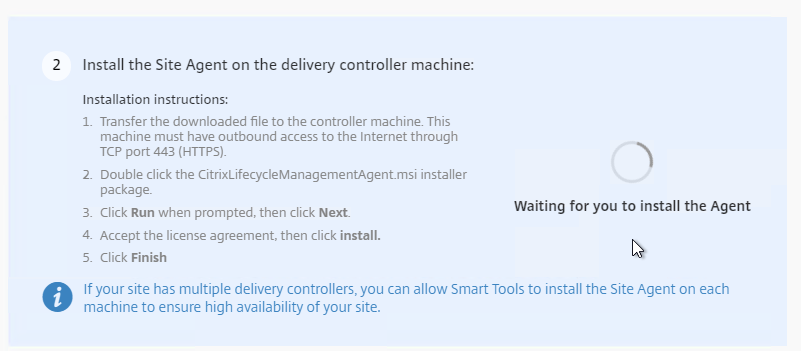
- On a Delivery Controller, run the downloaded CitrixLifecycleManagementAgent.exe.
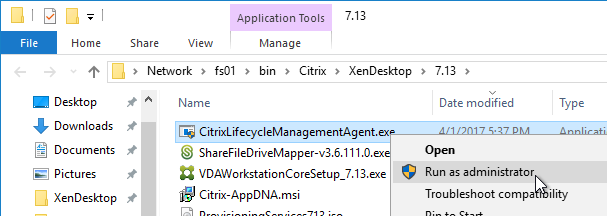
- Check the box next to I accept the terms in the License Agreement, and click Install.
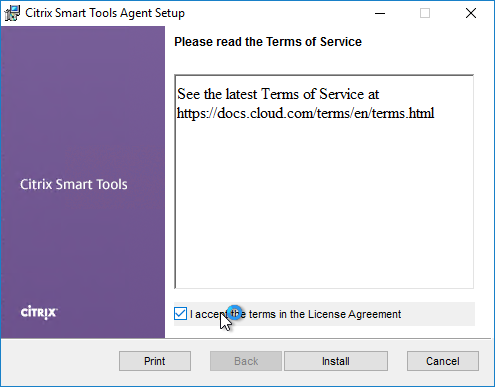
- In the Completed the Citrix Smart Tools Agent Setup Wizard page, click Finish.
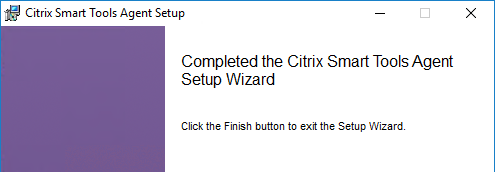
- Step 2 now shows that the Agent was installed successfully. Click Next.
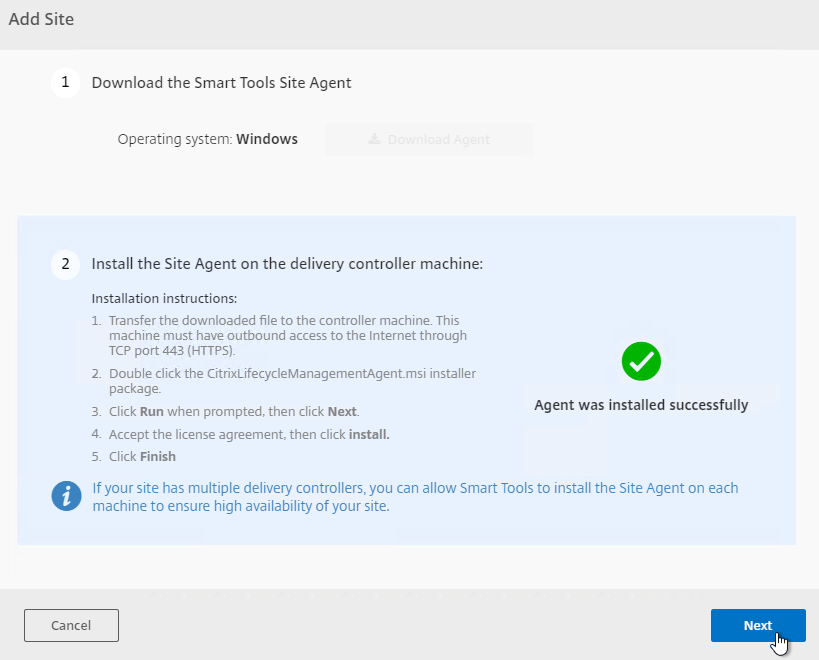
- Enter credentials for your XenDesktop farm, and click Add Site.
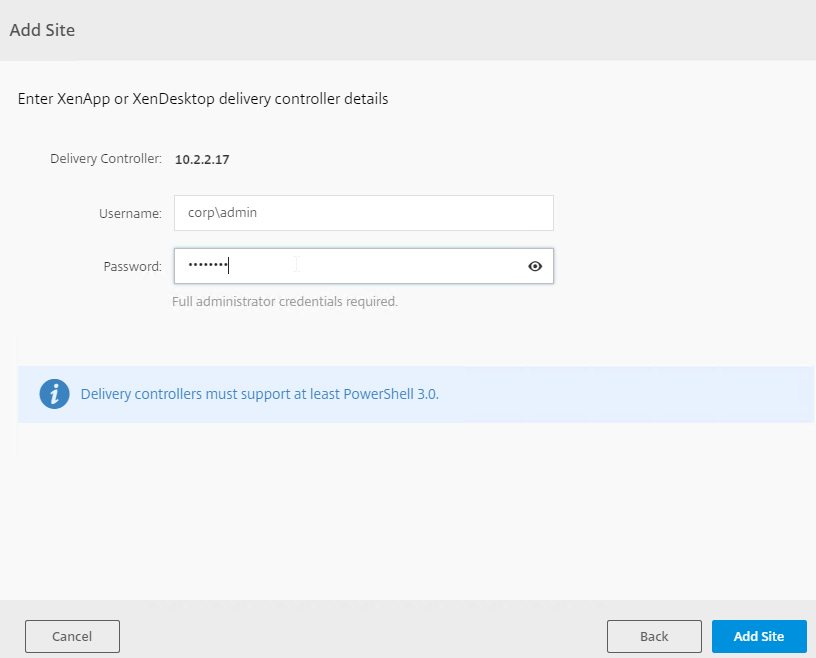
- Eventually you’ll see a Get Started link.
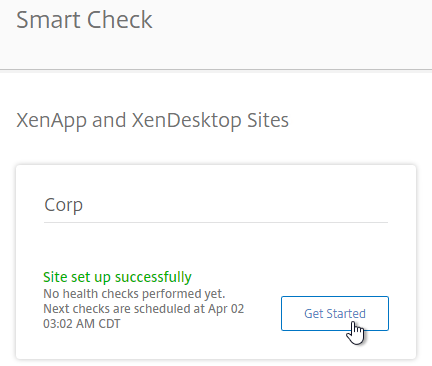
- Or, if the site is already added to your list of sites, click View Report next to the site.
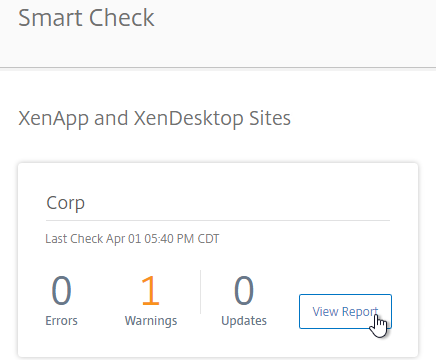
- At the top right, if you click Perform Check, you can run one of the checks.
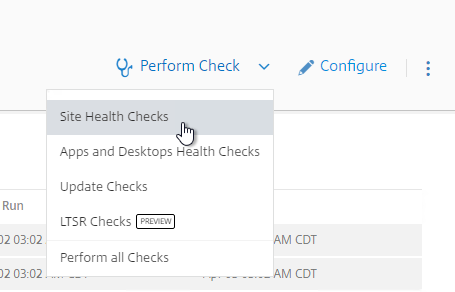
- If you click Configure.

- You can schedule the checks to automatically run periodically.
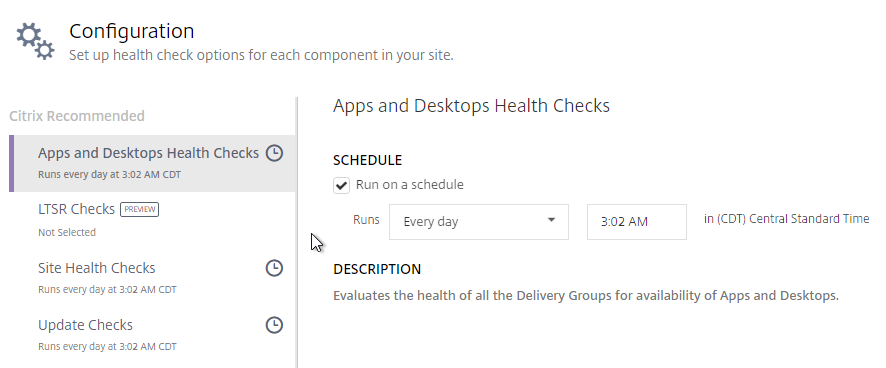
- To view the alerts, click one of the alert badges in the component category. Also see Smart Check alerts reference at Citrix Docs.
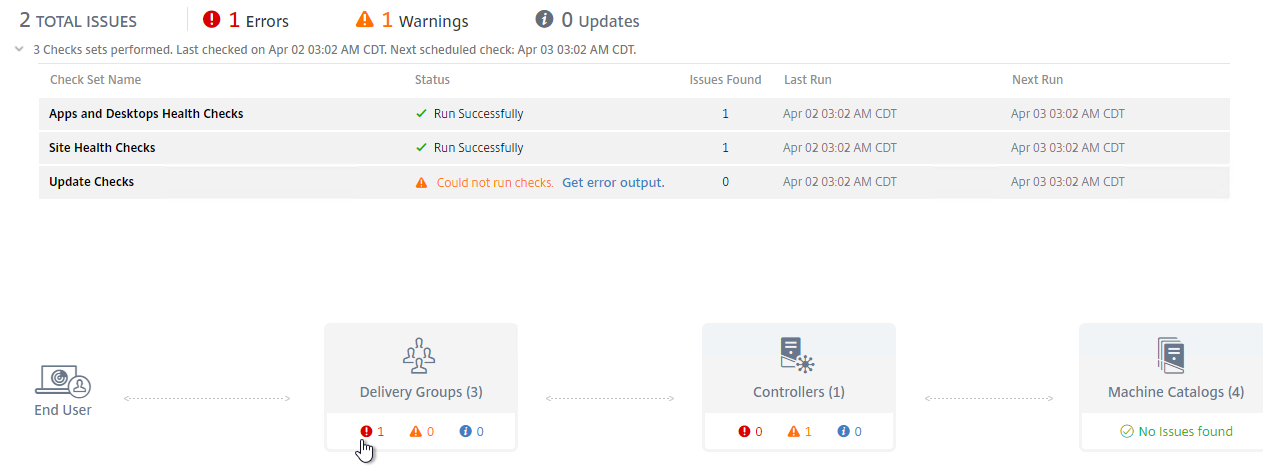
- Expand a component, and click an alert.
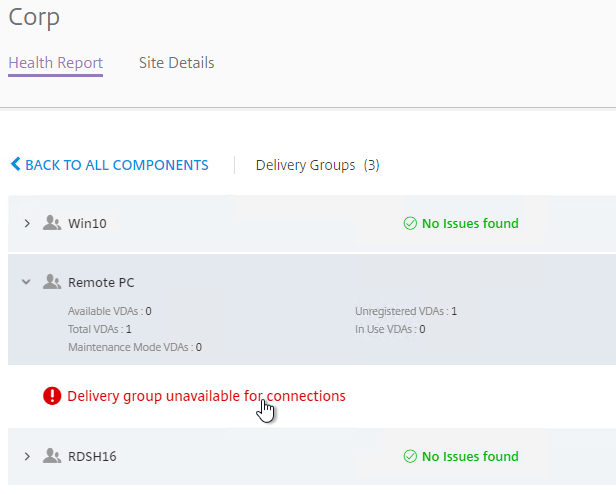
- On the right, there’s an option to Hide Alert.
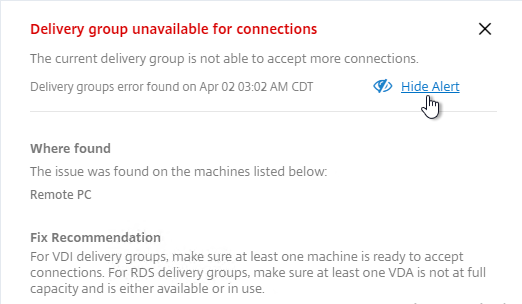
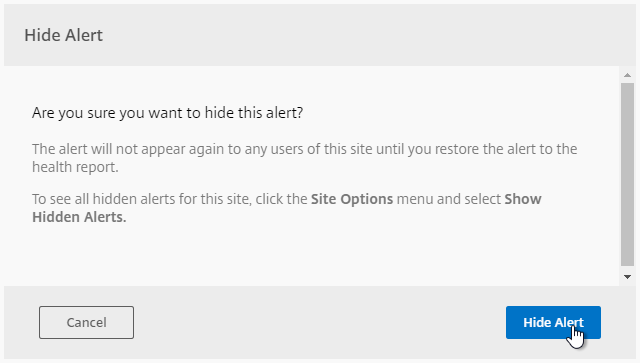
- To view the hidden alerts, at the top right, click the menu icon, and click Show Hidden Alerts.
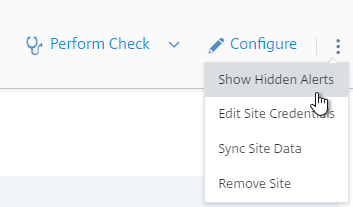
- The hidden alert is grayed out. If you click the alert, you can restore it.
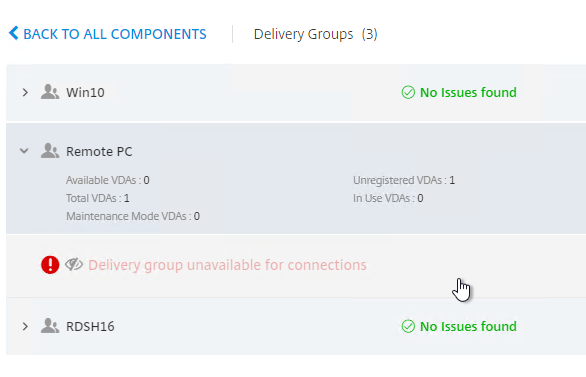
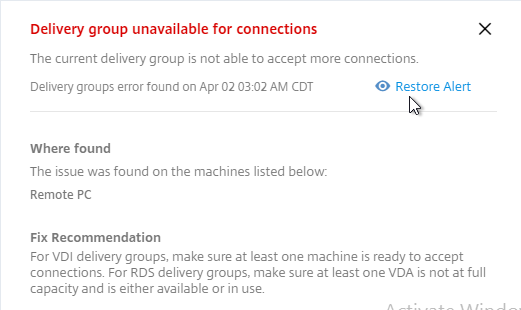
XenApp/XenDesktop Health Check
Sacha Tomet Finally 1.0 – but never finalized!: XenApp & XenDesktop 7.x Health Check script has now Version 1.0.
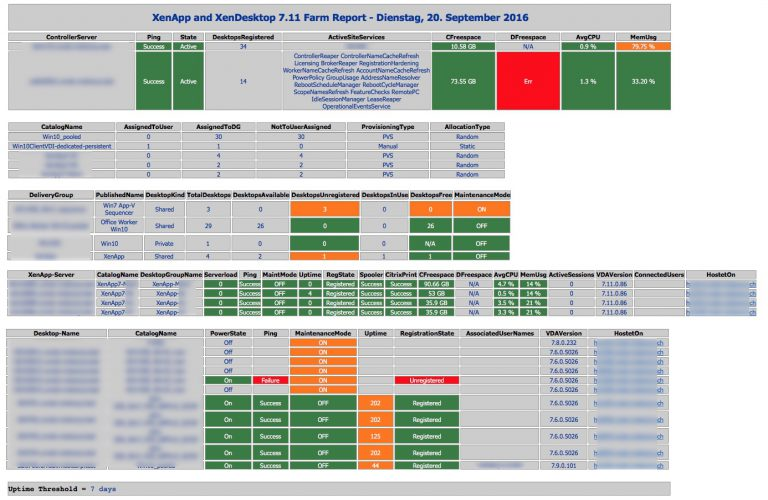
Andrew Morgan – New Free Tool: Citrix Director Notification Service: The Citrix Director Notification service sits on an edge server as a service (or local to the delivery controller) and periodically checks the health of:
- Citrix Licensing.
- Database Connections.
- Broker Service.
- Core Services.
- Hypervisor Connections.
And if any of these items fall out of bounds, an SMTP alert is sent to the mailbox of your choice for action. The tool will also send “All Clear” emails when these items are resolved, ensuring you are aware when the service has resumed a healthy state.
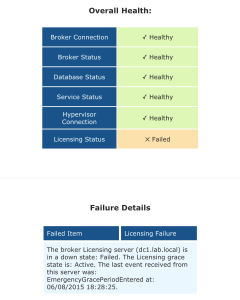
Matt Bodholdt XenDesktop 7.x Controller Service Status Script at CUGC – PowerShell script that checks the following:
- Lists Controllers with boot time
- Licensing status
- Service status on each Controller
- DB Connections
- Controller Available Memory
- Hypervisor Connections Status
Under the section where an administrator can choose to create the new site by creating the SQL script for the SQL DBA to execute. What happens if the original administrator that ran the Site Setup wizard is not available and we need to resume the installation once the databases are created? Is there a way to launch the Continue with Site Setup wizard?
I believe it will just work. If not, you might have to manually set the connection strings – https://www.carlstalhood.com/delivery-controller-1903-and-licensing/#changedbstrings
We are planning to build citrix 7.13 environment in AWS , how do we proceed with Vcenter part?
Hi Carl,
I would be great if you help me with an answer.
we have an existing machine catalog with machines that created by MCS.all are pooled random machines.now we need to update the machines with new patches.so i powered on the vm with golden image.updated the patches.
Can you help me from here?what is the next step?
Right-click the Catalog and click Update Machines.
Thanks for the reply..
But how the update transfer from the golden image to the machines.we are having an existing snapshot for the golden image and i have selected that snapshot while creating the machine catalog.so hsould i delete the existing snapshot?
If you select the machine itself, MCS will create a new snapshot and use that for the updated machines.
Yes, you should periodically delete older snapshots once enough time has elapsed that you don’t think you need to revert.
Thanks for the reply.
i have created the snapshot and select that snapshot instead of machine at the time of machine catalog creation.so machines are using that snapshot now.
i have updated the golden image now.
and powered off that vm that used to update the golden image.
Now should i delete the existing snapshot?and create a new snapshot and click on update machines option on catalog so that machines can boot from the new snapshot when they rebooted.please help me with this..
Yes, you should delete the old snapshot once a period of time has elapsed.
The Update Machines wizard for a Catalog prompts you to select a Master VM. If you click the VM itself, MCS will create a new snapshot and use that for updating the Catalog. Or you can create a snapshot yourself, and in the Update Machines wizard, expand the Master VM, and select the snapshot you created.
Hi Carl,
Do you know if there is any way to have Studio configuration changes written to the Windows Event logs? We have a very large environment and the resources are not available to track all changes at every site. It would be easier to pull events from windows event logs with a third party tool to see them all rolled up in one report. We currently have 22 sites that we manage. Logging into each site daily and creating a report for configuration changes is not feasible. Any thoughts on this?
Are the logging events in the logging database in a format you can query?
I am not sure about that. I would have to defer to our DBA for guidance. We are just looking for the easiest way to track configuration changes in the environment.
Hello Carl,
Hope you are well.
I have Xendesktop Enterprise license user/device and able to access RDSH hosted desktops without any issues but having issues accessing Remote PC as well as windows client based OS VDA’s. Do i need to have additional licenses to make this work?
Thanks,
Pavan
Go to Studio > Configuration > Licensing. What Model/Edition is selected? On the right is a link to Edit Production Edition. It needs to be XenDesktop.
Yeah it is set to Xendesktop Enterprise and having license for both user/device as well as concurrent. Still does not work in my case.
What error are you seeing? Check StoreFront Server, Event Viewer > Applications and Services > Citrix Delivery Services. Check Event Viewer on Delivery Controller.
No connection license available. To resolve, free licenses by closing sessions that are not needed, or add more licenses.
Details:
License Server Address: ‘xxxxx.desire4tech.local’
License Server Port: ‘27000’
Site License Model: ‘Concurrent’
Site Edition: ‘ENT’
ProductID: ‘XDT’
User: ‘xxx@DESIRE4TECH’
Client ID: ‘B2D4F37B’
Session Support: ‘MultiSession’
Maybe you own User/Device instead of Concurrent? In Studio, change it to User/Device and see if it works.
I have just tried to change it to user/device and it reaches a stage to login to the destop and then a black screen comes up and tells me “You cannot access this session because no licenses are available. I’m sure i have licenses more than required. I am trying to access windows 10 VDA. Is this included in Xendesktop enterprise licenses?
Yes, it’s included.
Firewall between Controllers and Licensing?
I can access the server 2012 R2 desktops fine just the remote PC and the windows 10 machines. Do you still think it might be a firewall issue?
You might have to contact Support so they can review your configuration. I can’t think of any other reason why it won’t work.
Thanks Carl. Much appreciate your time here.
Hi Carl,
I am installing Citrix XenDesktop 7.13 where I got the error while creating database from studio and also tried with manual creation of database as well but no luck.
My DDC and Database both having different domain forest and between this two we cannot create trust relationship due some restriction of company
Please guide me how can I proceed this without trust between this domains.
Pleases refer the below database logs error while database creating.
Error Id: XDDS:1FDE0F02
Exception:
Citrix.Console.Models.Exceptions.ScriptException Failed to update database CitrixLabCitrixSite on server msmumdb.
at Citrix.Console.PowerShellSdk.DatabaseService.Scripts.UpdateDatabaseScript.DoImpersonatedWork()
at Citrix.Console.PowerShellSdk.DatabaseService.Scripts.CreateDatabaseScript.DoImpersonatedWork()
at Citrix.Console.PowerShellInteraction.ThreadedDatabaseScript`1.RunScript()
at Citrix.Console.PowerShellInteraction.PowerShellScript`1.Run()
at Citrix.Console.PowerShellSdk.DatabaseService.Scripts.CreateProductAndMirrorDatabaseScript.RunScript()
at Citrix.Console.PowerShellInteraction.PowerShellScript`1.Run()
at Citrix.Console.PowerShellSdk.SiteService.Scripts.CreateEmptySiteScript.RunScript()
at Citrix.Console.PowerShellInteraction.PowerShellScript`1.Run()
at Citrix.Console.PowerShellSdk.SiteService.PSSiteService.EmptyDeploymentScript(IDictionary`2 credentials, ConfigSiteInformationModel configSiteModel, SiteSetupModel siteSetupModel, LicenseCertificateModel licenseCertificateModel, Boolean partOfFullDeployment, IProgressReporter progressReporter, ScriptExecutionContext scriptExecutionContext, String configurationLoggingTitle)
at Citrix.Console.DeliveryCenter.UI.Dialogs.FullDesktopDeploymentWizardViewModel.CompleteDeployment(IProgressReporter progressReporter)
at Citrix.Console.DeliveryCenter.UI.Dialogs.DeploymentWizardViewModel.Commit(IProgressReporter progressReporter)
DesktopStudio_ErrorId : DatabaseError
SqlServerOutput : msmumdb: CitrixLabCitrixSite: Changed database context to ‘CitrixLabCitrixSite’.
msmumdb: tempdb: Changed database context to ‘tempdb’.
msmumdb: tempdb: Changed database context to ‘tempdb’.
msmumdb: CitrixLabCitrixSite: Changed database context to ‘CitrixLabCitrixSite’.
ErrorCategory : NotSpecified
DesktopStudio_PowerShellHistory : CreateDatabaseScript
12/05/2017 7:30:26 PM
Inner Exception:
Microsoft.SqlServer.Management.Smo.FailedOperationException ExecuteNonQuery failed for Database ‘CitrixLabCitrixSite’.
at Microsoft.SqlServer.Management.Smo.Database.ExecuteNonQuery(StringCollection sqlCommands, ExecutionTypes executionType)
at Citrix.Console.PowerShellSdk.DatabaseService.Scripts.UpdateDatabaseScript.DoImpersonatedWork()
HelpLink.ProdName : Microsoft SQL Server
HelpLink.BaseHelpUrl : http://go.microsoft.com/fwlink
HelpLink.LinkId : 20476
HelpLink.ProdVer : 11.0.5058.0 ((SQL11_PCU_Main).140514-1623 )
HelpLink.EvtSrc : Microsoft.SqlServer.Management.Smo.ExceptionTemplates.FailedOperationExceptionText
HelpLink.EvtData1 : ExecuteNonQuery
HelpLink.EvtData2 : Database
Inner Exception:
Microsoft.SqlServer.Management.Common.ExecutionFailureException An exception occurred while executing a Transact-SQL statement or batch.
at Microsoft.SqlServer.Management.Common.ServerConnection.ExecuteNonQuery(String sqlCommand, ExecutionTypes executionType)
at Microsoft.SqlServer.Management.Common.ServerConnection.ExecuteNonQuery(StringCollection sqlCommands, ExecutionTypes executionType)
at Microsoft.SqlServer.Management.Smo.ExecutionManager.ExecuteNonQuery(StringCollection queries, ExecutionTypes executionType)
at Microsoft.SqlServer.Management.Smo.Database.ExecuteNonQuery(StringCollection sqlCommands, ExecutionTypes executionType)
Inner Exception:
System.Data.SqlClient.SqlException Windows NT user or group ‘IPCACDS\DIRECTOR$’ not found. Check the name again.
Failed to create login [IPCACDS\DIRECTOR$] for controller [IPCACDS\DIRECTOR$] (login may already exist but with the wrong SID)
at Microsoft.SqlServer.Management.Common.ConnectionManager.ExecuteTSql(ExecuteTSqlAction action, Object execObject, DataSet fillDataSet, Boolean catchException)
at Microsoft.SqlServer.Management.Common.ServerConnection.ExecuteNonQuery(String sqlCommand, ExecutionTypes executionType)
HelpLink.ProdName : Microsoft SQL Server
HelpLink.ProdVer : 12.00.4100
HelpLink.EvtSrc : MSSQLServer
HelpLink.EvtID : 15401
HelpLink.BaseHelpUrl : http://go.microsoft.com/fwlink
HelpLink.LinkId : 20476
Sorry, XenDesktop uses Kerberos to authenticate to SQL. Unfortunately there’s no option for SQL auth.
Hello Carl,
I have a license information sent through a browser looks like it is copy and pasted and want to check how can i save it and upload it to the licensing server. I did copy and paste to a text file and saved as .lic extension but the licensing console does not seems to be detecting it.
Much appreciate your help on this.
Thanks,
Pavan
Are you able to login to myCitrix.com and download the license file again?
Otherwise, I wonder if the license file needs to be in UNIX format.
Thanks for your reply Carl. Sorry the license has been sent by someone to me through an email and I have pasted it on a notepad which did not work. I wonder if i need to convert it etc?
When I review the upgrade process of the Delivery Controller, and Studio.
Is it correct that during the Database upgrade now new users can log-on.
So there’s no interruption for all connected users?
Correct.
can we check the License servers details like version, name through command from any of the citrix server ?. I am asking this for any version 5.0, 6.5, 7.6 or 7.12
In 6.5 and older, I think this is in the registry somewhere. Either under Policies or under the main Citrix HKLM registry key.
In 7.x, Controllers handle licensing. Get-BrokerConfigSite I think has the address. You’d have to view the version on the License Server itself.
Hi Carl, can i upgrade the license, storefront, director and studio to 7.13 (from 7.6) without impact to our users? We have 2 storefronts (load balancer) and 2 studio servers. That means updating one by one. Also the old VDA version 7.6.300 can cannot to the new 7.13 environment? thanks in advance
Old VDA can talk to new Controller.
New VDA can talk to old Controller.
If there are no problems during the upgrade, yes, you can upgrade one, failover your SF load balancer, and upgrade the other.
Have been working on a Fresh 7.13 XenApp install.
I had no issues installing the first Delivery controller, but when I install the second Delivery controller it always bombs out.
I have reverted to 7.12, which installs without an issue.
There should be some installation logs. Under %localappdata%\Temp\Citrix or something like that.
In our old XA 6 environment we load balanced our ZDCs via the NetScaler. Is it still a good option to do this with 7.13 and then input the VIP into the SF servers, or just add them one by one to the SF and check the load balanced checkbox?
I still have a bad taste from troubleshooting old XML load balancing performance issues so I generally avoid it. I suspect there isn’t much benefit to NetScaler load balancing since StoreFront does a better job of detecting failures.
On licensing – I’m unsure why Citrix do not support the VPX License Server for XA7.13? I’ll now have to build a Windows server, install License Server onto it and then migrate my licenses to it. Does anyone know why the VPX doesn’t support these later versions?
Do you know which SA date is required for 7.13? Can’t seem to find it anywhere.
2017.0215
Every time i try to upgrade the storefront fails and every time i have to reinstall sf from scratch. Am i the ony one who has this problem ?
You’re definitely not the only one. Citrix would like you to contact them (Citrix Support) so they can determine the cause and try to prevent in the future. My advice is to snapshot the VM, and be prepared to roll back.
When trying to upgrade the Citrix Licensing Server from 11.4.0 Build 18001 on a Windows 2016 server it does nothing when launching the installer. Even after uninstalling the license server and rebooting the server it still does not want to install. As an alternative when I tried using the XenDesktop 7.13 ISO the Citrix License Server is grayed out says “included in upgrade”.
Are you running the .exe, or the .msi?
I first tried the exe, then the msi while logged in as the administrator account the installed it in the first place. Neither worked but when I ran the exe from an elevated command prompt I was able to successfully update the license server. Problem solved.